Summer is a time of adventure and fun for both humans and their canine companions. However, the sweltering heat and unique challenges of the season can pose risks to our furry friends. As responsible pet owners, it’s crucial to ensure our dogs remain safe, healthy, and comfortable during the hottest months of the year. Here are six essential summer safety tips to keep your dog cool, hydrated, and protected.

Keep your dog cool
As pet owners, your primary concern during summer is preventing your dog from overheating. But unlike humans, dogs don’t sweat. Instead, they rely on panting and releasing heat through their paws and nose to cool down. So in order to help them stay cool this summer, try to limit outdoor play to dawn and dusk hours to avoid peak heat and temperatures. And when you are in the great outdoors, be sure to always provide your pup access to shady spots.
One of the best ways to keep your canine cool this summer is by creating a cool retreat at home with fans or air conditioning. You can also use dog cooling mats or vests specifically designed for dogs. Frozen treats and ice cubes can also be a fun and refreshing way for your dog to cool off. Just place some frozen homemade treats in their dog bowl after an evening walk to enjoy as they cool down.
Adjust walk times and avoid hot pavement
Taking your dog for walks is essential, but during summer, the timing and surface can make a big difference. When the temperatures rise, pavement and asphalt can become dangerously hot, potentially causing burns to your dog’s sensitive paw pads. So how do you know if it’s too hot to take your dog on a walk?
Before putting your dog’s favorite collar and leash on, first test the pavement with the back of your hand; if it’s too hot for you to touch for more than a few seconds, it’s too hot for your dog. Instead, opt for early morning or late evening walks when temperatures are lower. If walking on hot surfaces is unavoidable, consider protective booties for your dog’s paws or stick to grassy, shaded areas.
Keep your dog hydrated
Ensuring your dog stays hydrated during the summer months is crucial for their health and well-being. As temperatures rise, dogs can quickly become dehydrated, which can lead to serious health issues like heatstroke. To keep your furry friend hydrated, always provide fresh, cool water in their dog bowls and carry a portable water bowl or a water bottle with a built-in dispenser during walks or outings. During summer it’s important to pay attention to signs of dehydration, such as excessive panting, dry gums, or lethargy. If you notice any of these symptoms, offer water immediately and move your dog to a cooler area.
To make hydration more appealing, you can also incorporate hydrating treats into your dog’s diet. Freeze chicken broth or water mixed with a bit of low-sodium beef broth into ice cube trays for a refreshing, hydrating snack. You can also offer fruits like watermelon, which is not only hydrating but also a favorite treat for many dogs. And during playtime, opt for water-based activities like sprinklers, lakes, or the pool, providing both fun and hydration. Just be sure to monitor them when in open bodies of water to ensure they don’t drink the water and make sure they are rinsed off with clean water after all swim activities.
Schedule a vet appointment
Just like humans, dogs are susceptible to heat-related illnesses such as heatstroke and dehydration. By scheduling a vet visit early in the season, you can get ahead of any potential health issues and receive professional advice tailored to your pet’s specific needs. Your vet can check for any underlying conditions that might be exacerbated by the heat, update vaccinations, and even offer tips on keeping your furry friend cool and comfortable during the hottest months. It’s also an excellent opportunity to discuss the best flea and tick prevention strategies, as these pests thrive in warmer weather.
Before the vet checkup, make a list of questions about summer care, like how much water your dog should be drinking or the best times for walks to avoid peak heat. Additionally, consider scheduling the appointment during the cooler parts of the day, like early morning or late evening, to make the trip less stressful for your pet. And don’t forget to bring along a favorite toy or treat to keep them calm and comfortable during the visit. Taking these steps not only prepares you for a productive vet visit but also demonstrates your dedication to your dog’s health and happiness throughout the summer.
Watch out for insect bites
Mosquitoes, ticks, and fleas are more active during the warmer months and can cause discomfort or even health issues for your dog. Regularly check your dog’s coat and skin, especially after walks in wooded or grassy areas. Pay close attention to areas like the ears, belly, and between the toes where ticks often hide. A quick daily inspection can help you spot and remove ticks before they latch on. Remember, it’s not just about looking for insects; also watch for signs of bites, such as excessive scratching, redness, or swelling.
To protect your dog, consider using vet-approved insect repellents and preventatives. There are various options, including topical treatments, collars, and oral medications, so you can choose what works best for your dog’s lifestyle and needs. Keep your yard well-maintained by mowing the lawn regularly and removing any standing water, which can be breeding grounds for mosquitoes. Additionally, washing your dog’s bedding frequently can help minimize the risk of flea infestations. The Topology dog bed designed by Omlet offers easy to remove and wash covers, making it a great bed choice for your dog every month of the year.
Safe traveling in the car
Summer often means road trips and vacations, and bringing your dog along can be a lot of fun. However, it’s important to ensure they stay comfortable and safe during car rides. First and foremost, always ensure your dog is properly secured in the car, either with a pet seat belt or in a dog crate. This not only keeps them safe but also prevents distractions while driving.
Remember to never leave your dog alone in a parked car. In summer, temperatures can rise to dangerous levels in just minutes, even with the windows cracked. Regularly stopping for water breaks and allowing your dog to stretch their legs will help keep them hydrated and comfortable during the journey. To ensure your dog’s comfort in the car during summer travels consider the Omlet cushion dog bed. This bed is not only lightweight and easy to transport but also provides a cozy and familiar spot for your dog to rest, no matter where your travels take you. Its durable design is perfect for outdoor use, whether you’re camping, visiting the beach, or stopping at a pet-friendly hotel.
Omlet and your dog
At Omlet, we understand that your dog’s safety and happiness are paramount, especially during the summer months. Our team of pet enthusiasts and experts designs products with a deep understanding of what dogs need to thrive in any weather. From innovative dog crates to travel dog bed solutions, Omlet’s range of products is crafted to keep your pup safe and comfortable, no matter the temperature outside. Trust us to provide the best for your furry family members, ensuring both of you enjoy a fantastic, worry-free summer.
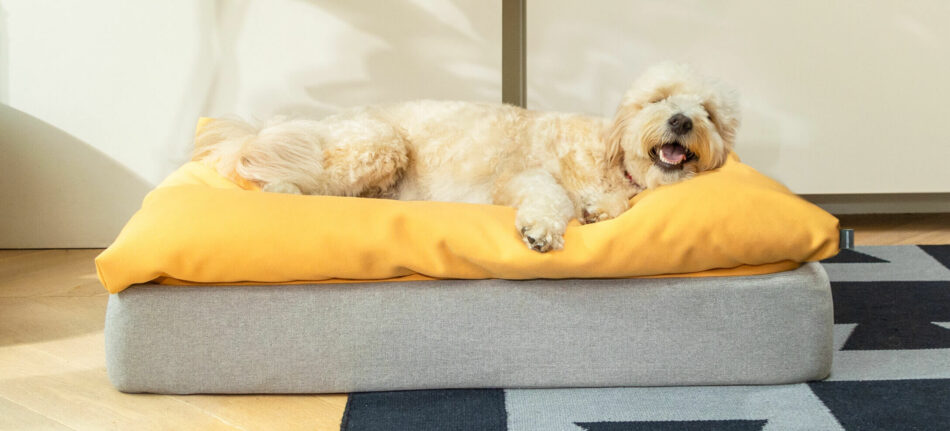

This entry was posted in Dogs
As the mercury rises, it’s essential to consider not just our own comfort but also the well-being of our furry friends. Dogs, with their fur coats and limited ability to cool themselves, can struggle in hot weather. Understanding how to care for your dog during the summer months is crucial to ensure they remain happy and healthy. This guide will explore how to keep your dog comfortable in the heat, recognize when it’s too hot, and offer tips on cooling them down.
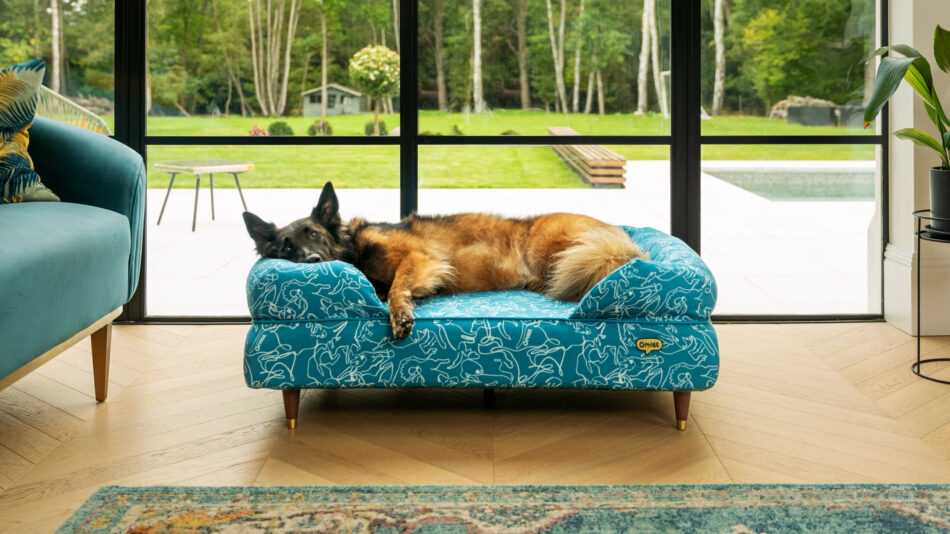
How to know if it’s too hot for fido?
When the summer sun is blazing, it’s crucial to ensure your furry friend stays safe and comfortable. One of the best ways to determine if it’s too hot for fido is by feeling the pavement with your own bare feet. If the surface is too hot for you to stand on for more than a few seconds, it’s definitely too hot for your dog’s sensitive paws.
Know the signs of overheating
Remember, dogs regulate their body temperature differently than humans and can quickly overheat, leading to dangerous health issues like heatstroke. So pay close attention to your pet’s behaviors and look out for these signs;
- Excessive panting
- Drooling
- Lethargy
- Anxiety
- General discomfort
These are all red flags that it’s time to get them indoors and cooled down immediately.
Another critical indicator is the ambient temperature and humidity levels. Dogs are more susceptible to heat stress when the temperature exceeds 85°F (30°C), especially if they have a thick coat or are a flat-nose breed like bulldogs or pugs. Ensuring your dog has access to shade, fresh water, and avoiding walks during peak heat hours are essential precautions. Additionally, consider their activity level—playful pups might not realize they’re overheating. By taking these steps, you can ensure Fido stays happy and healthy, ready to enjoy the summer by your side without the risk of heat-related ailments.
What to do with your dog when it’s hot
During hot weather, modifying your dog’s routine is essential to prevent overheating. Start by ensuring they have access to plenty of fresh, cool water at all times, and avoid taking them out during the peak heat of the day. Instead, opt for early morning or late evening walks when the pavement is cooler and the sun less intense.
Consider investing in a dog cooling mat or vest, which can provide significant relief from the heat. If your dog enjoys water, a kiddie pool in the shade can be a fun and effective way to help them stay cool while getting some exercise.
Another great way to beat the heat is by creating a cool indoor haven for your furry friend. Keep the blinds drawn and the fans or air conditioning on to maintain a comfortable temperature. Engage your dog with indoor activities, such as interactive dog toys and brain games, to keep them mentally stimulated without overheating. Homemade frozen treats, like ice cubes with embedded dog-safe fruits, can be a delightful way to cool down.
Remember, if your dog shows signs of overheating, such as excessive panting, drooling, or lethargy, it’s important to act quickly and consult a veterinarian. Keeping your dog cool during hot weather is essential for their health and happiness, and with a little creativity, you can ensure they stay safe and comfortable all summer long.
What to do if your dog is too hot
Preventative measures are crucial to avoid overheating in the first place. So when summer temps rise, avoid strenuous activity during the hottest parts of the day and provide ample shade and water. And never leave your dog in a parked car. But if your dog still shows signs of overheating, it’s critical to act quickly.
- Move them to a cooler environment immediately.
- Offer fresh, cool water to drink but avoid forcing them to drink if they aren’t interested.
- Apply cool (not cold) water to their body, focusing on the paws, belly, and neck to help lower their temperature gradually.
- Monitor your dog’s temperature and watch for signs of improvement or worsening.
Having read this guide you will be equipped to manage your pooch if they’re too hot, however, in cases where symptoms are severe, seek veterinary attention immediately. Heatstroke can escalate quickly and can be fatal if not treated promptly. While waiting for veterinary help, you can help cool your dog by wetting their coat with cool (not cold) water and using fans to increase evaporation. Avoid using ice-cold water or ice packs directly, as this can cause the blood vessels to constrict and reduce the cooling effect.
Omlet and your dog
At Omlet, we understand that every dog is unique and requires special care, especially in extreme weather conditions. That’s why we ask the right questions to tailor our products to meet the needs of all dogs, no matter the temperature. Our innovative solutions, from dog cooling mats to designer dog beds for much needed rest, are designed to ensure your dog stays comfortable and safe. With Omlet, you and your dog can enjoy each other’s company to the fullest, even during the hottest days of the year.
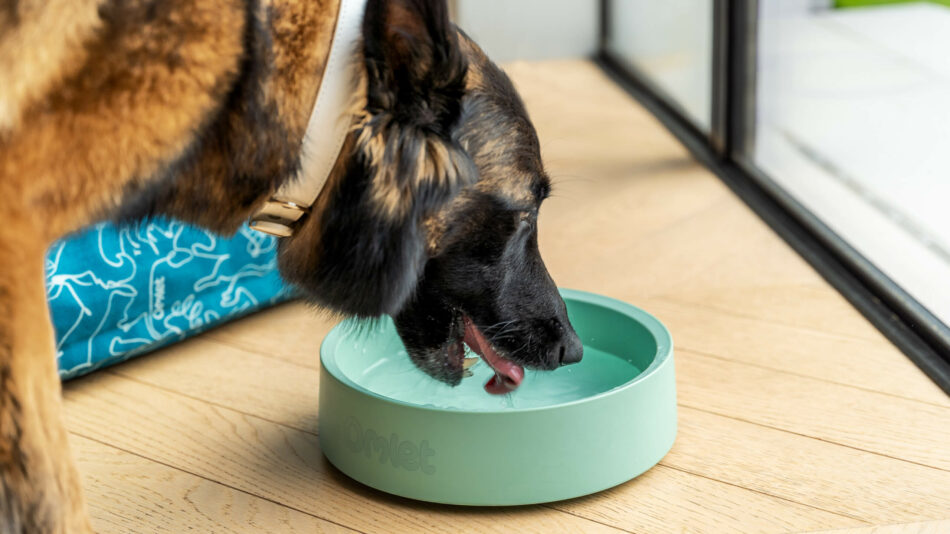

This entry was posted in Dogs
Imagine this: your beloved dog, a picture of playful vitality, suddenly starts scratching incessantly, develops red, watery eyes, or suffers from persistent sneezing fits. These could be signs of common dog allergies, an often overlooked but significant issue affecting our furry friends. In this blog, we’ll delve into the world of canine allergies, uncovering the triggers, symptoms, and treatments that can help you restore your dog’s comfort and happiness. Whether it’s seasonal pollen, certain foods, or unexpected environmental factors, understanding and addressing these allergies is crucial for the well-being of your loyal companion.
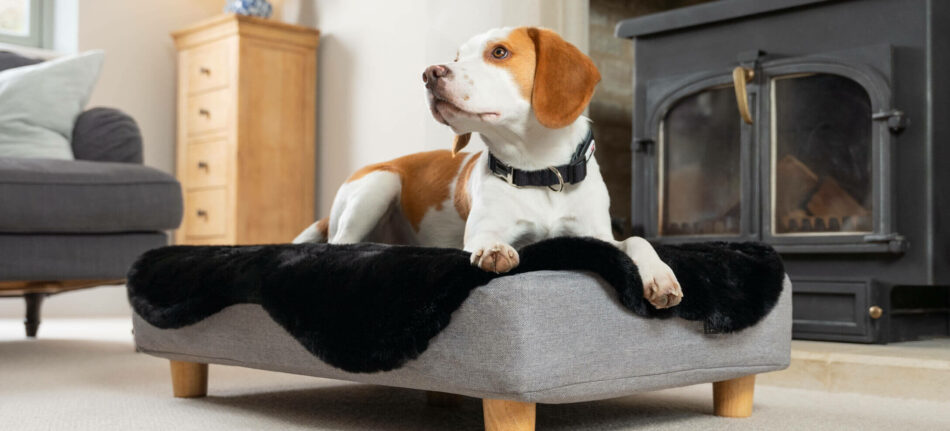
Can dogs get allergies?
Yes, dogs can get allergies, just like humans. But what exactly is an allergy in dogs? An allergy is simply an overreaction of the immune system to a typically harmless substance, known as an allergen. When the body encounters an allergen, it mistakenly identifies it as a threat and produces antibodies to fight it off. This immune response results in various symptoms that can range from mild to severe.
Canine allergies manifest when a dog’s immune system reacts to specific substances in their environment, food, or other factors. These allergic reactions can cause significant discomfort and health issues for our furry friends. So recognizing the signs and types of allergies in dogs is essential for managing their well-being effectively.
Symptoms of dog allergies
Dog allergies can present in various ways, often making them challenging to diagnose. Here are some common symptoms to watch for:
- Itchy skin: This is the most notable and common of all dog allergy symptoms. Manifesting through frequent scratching, licking, or biting at the skin, itchy skin can often lead to redness and irritation.
- Skin rashes and hives: While similar to regular itchy skin, rashes and hives present more as red, inflamed patches on the skin. Typically these are a result of exposure to a specific allergen.
- Chronic ear infections: Does your dog shake its head or itch their ears often? This could be as a result of an ear infection. Recurring ear issues are often associated with discharge and odor and are often directly related to some type of allergic reaction.
- Runny nose and watery eyes: Just like humans, dogs who suffer from allergies often have runny noses and watery eyes. The clear discharge from the nose and excessive tearing is usually as a result of inhaling an allergen or sniffing too close to one.
- Paw chewing/licking: Itchiness from allergies is not selective just to the skin – it can impact a dog’s paws, too. If you notice your dog persistently licking or chewing at their paws, they could very well be experiencing allergies.
- Digestive issues: Symptoms such as vomiting, diarrhea, or other gastrointestinal problems are often directly related to a food allergy. Pay close attention to your dog’s reactions and notice if these digestive issues appear right after eating. If so, they likely have a food allergy.
- Behavioral changes: Humans with allergies know all too well how uncomfortable these symptoms can be. The same is true for dogs. Increased irritability, restlessness, or lethargy are all common changes in behavior for dogs who suffer from allergies.
Recognizing these symptoms early can help you seek appropriate treatment for your dog’s allergies and prevent further complications.
Types of dog allergies
Dogs can suffer from several types of allergies, each with its own set of triggers and symptoms. Understanding the type of allergy affecting your dog is crucial for effective management and treatment. Here are some of the main types of dog allergies:
- Food allergies: While food allergies are the least common of canine allergies, they can still cause severe issues. Reactions to specific ingredients in their diet, such as beef, chicken, dairy, or grains, can lead to digestive problems, skin irritations or other allergic symptoms.
- Environmental allergies: Sensitivities to pollen, mold, dust mites, and other airborne allergens are some of the most common causes of canine allergies. While most dogs are impacted seasonally, indoor allergens can cause year-round allergies as well.
- Skin allergies: If you’ve noticed any hot spots or bald patches on your dog, they are likely suffering some type of skin allergy. Often caused by flea bites or other direct contact, your dog will itch with such frequency it will result in flea allergy dermatitis.
- Contact allergies: Did you know dogs can be allergic to certain shampoos, fabrics or cleaning products just like humans? If you notice your dog itching a lot after coming in contact with a new product, refrain from using it to be sure you don’t cause any continued allergic reactions.
Breeds more susceptible to allergies
Certain dog breeds are more prone to allergies due to their genetic predispositions and body makeup. Breeds like golden retrievers, bulldogs, pugs, boxers, and terriers are all dogs that are particularly susceptible to allergies. Factors such as breed-specific skin characteristics, immune system variations, and common hereditary conditions contribute to their increased risk of developing allergies.
For instance, bulldogs and pugs have more skin folds, which can trap allergens and moisture, leading to skin infections and allergic reactions. Whereas golden retrievers and boxers often have genetic predispositions to food and environmental allergies. Knowing your dog’s breed-specific risks can not only help you take preventive measures but also allow you to seek early intervention from your vet when needed.
Creating an allergy-free zone at home
Maintaining an allergy-free environment is paramount for dogs suffering from allergies. This involves regular cleaning of their spaces to reduce allergens such as dust mites, pollen, and mold. Does your dog sleep in your room or find a sanctuary in their dog den? Using air purifiers near these spaces and keeping windows closed during high pollen seasons can help alleviate the allergens. Frequent bathing with hypoallergenic shampoos can also help minimize skin irritation and remove allergens from your dog’s coat.
Omlet’s line of dog beds can be an invaluable addition to your allergy management toolkit. Ingenious designs such as the Topology dog bed and Cushion dog bed come with easy-to-remove, machine-washable covers that help keep allergies at bay. Additionally, Omlet offers elevated dog beds that keep your dog off the floor, reducing their exposure to dust and other allergens commonly found on the ground. By incorporating Omlet’s dog beds into your home, you can create a cleaner, more comfortable space for your allergy-prone pet.
Omlet and your dog
At Omlet, we understand the unique needs of dogs and strive to design products that enhance their well-being and comfort. Our commitment to quality and innovation is driven by our desire to make life with your pet as joyful and hassle-free as possible. Whether it’s providing easy-to-clean dog beds or safe haven dog dens, Omlet is dedicated to improving the bond between you and your furry friend. Explore our range of products today and discover how we can help you and your dog live a healthier, happier life together.


This entry was posted in Dogs
Rescuing a dog can be a truly rewarding experience. Not only will you receive a loving companion in the process, but this selfless act gives a deserving animal a new lease on life. Like any big commitment, it’s important to be prepared for the journey ahead. Whether you’re a first-time dog owner or an experienced pet parent, here’s things you should know when rescuing a dog, along with tips and products to make the transition as smooth as possible.
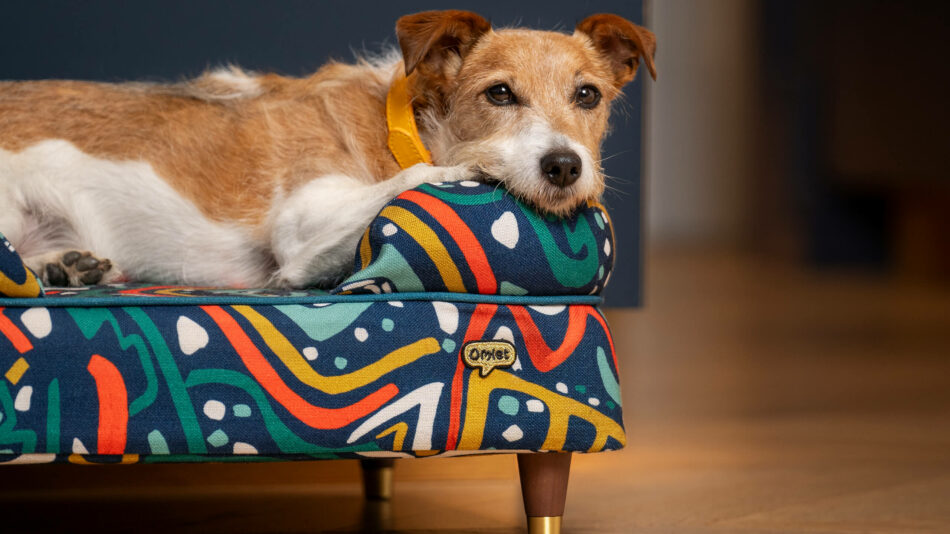
Assess your home and lifestyle
Bringing a rescue dog into your home is an exciting and rewarding experience, but it’s crucial to assess your environment and lifestyle to ensure a smooth transition for both you and your new four-legged friend. Start by evaluating your home’s physical design. Consider the size of your living space and whether you have a yard, patio, or nearby park for exercise. Depending on what dog breed you decide to rescue, your new furry friend may have different needs to consider.
If you live in an apartment or a rental property, be sure to check the pet policies to avoid any surprises. Additionally, think about the layout of your home—are there stairs, open balconies, or other areas that might be unsafe for a curious dog? It’s also a good idea to identify in advance the places where your new dog can sleep on their dog bed, eat in comfort, and have a secluded space where they can retreat in peace.
Beyond the physical setup, reflect on your daily routine and social commitments. Do you work long hours, travel frequently, or have an active social life? Consider how much time you can dedicate to your dog’s needs, including feeding, exercise, and training. If you’re not home often, who will care for your dog, and what arrangements need to be made? Think about your social network—do you have friends or family who can help with dog-sitting in a pinch?
And finally, consider your family’s dynamics and whether everyone is on board with the responsibilities that come with adopting a dog. By assessing both your home and lifestyle, you can ensure you’re creating a welcoming environment for your rescue dog and setting yourself up for a successful adoption experience.
Preparing your home for your new friend
Once you’ve decided to rescue a dog, it’s time to prepare your home for their arrival. Dogs thrive in environments where they feel safe and secure. A great way to provide this is by investing in high-quality dog products that will give your new furry friend comfort and longevity.
- Dog crate: Not only does a dog crate serve as a useful training tool, but it can double as a safe and comfortable hideaway where your rescue dog can rest with ease. The Fido Nook Dog House, designed by Omlet, is a perfect choice for rescue dogs as its sleek, modern design makes it feel more like furniture than a crate. The luxury inspired design not only creates a warm and inviting environment for your dog, but looks good in your home as well.
- Dog bed: In addition to a crate, a comfortable dog bed is a must-have product for your new pup. If you’re rescuing an older dog, opt for orthopedic options to support their joints, like the Bolster dog bed from Omlet. For younger dogs, look for durable beds that can withstand their energy and occasional messes, like Omlet’s easy-to-clean Topology dog bed.
- Leash and collar: An essential part of being a dog owner is making sure your rescue dog gets exercise. So invest in a durable dog collar and leash that you can use on walks around the block, trips to the dog park, or even the occasional road trip. The Omlet designer dog collars and leashes allow you to match your dog’s personality to their wears, which adds flair and inspiration to your time together.
- Dog toys: No matter what age, breed, or size of your rescue, all dogs like to play with toys. So be sure to have plenty of interactive dog toys on hand for your new friend to play with and stay mentally stimulated. Set aside time each day to play with your dog as this will help to quickly strengthen the bond between the two of you.
Building trust and boundaries
Bringing a rescue dog into your life is like starting a new chapter with an old friend. The key to building trust is patience and consistency. Rescue dogs often come with a history of uncertainty, so it’s important to give them time to adjust. Start by establishing a routine that helps them understand what to expect from day to day. Feeding them at the same time, taking regular walks, and creating a designated sleeping area can help create a sense of stability. As they start to relax, you’ll notice their unique personality traits and preferences.
Along with building trust, establishing boundaries is just as crucial and its success is in finding the right balance. Dogs feel more secure when they know what is and isn’t allowed. But remember, this isn’t about strict discipline—it’s about guiding them with kindness. Use positive reinforcement to teach them acceptable behaviors, like sitting before crossing the street or not jumping on guests. If they’re not allowed on the couch, redirect them to their bed with a toy or treat. By creating clear, consistent boundaries, you’re not only guiding your dog but also showing them that you care enough to keep them safe.
Introducing family and pets
When it comes to introducing your rescue dog to family members and other pets, planning and patience is key. Start by having a designated space for your new dog where they can feel secure and get used to their surroundings without feeling overwhelmed. This could be a room or a quiet corner with their bed, toys, and food. When introducing them to family members, keep things low-key and avoid crowding the dog. Allow them to approach people at their own pace, and use dog treats to create positive associations with new faces.
If you have other pets, a gradual introduction is crucial. Start by letting them sniff each other’s scent through a closed door or baby gate. This helps both pets get used to the idea of a new companion without direct interaction. After a day or two, you can progress to short, supervised meetings in a neutral area, like the backyard or a spacious living room. Keep the interactions brief and positive, with plenty of treats and praise and watch for signs of stress or aggression. Over time, with patience and positive reinforcement, your rescue dog will start to feel like part of the family, and your other pets will adjust to the new addition. Remember, every dog is different, so take things at a pace that feels comfortable for everyone involved.
Omlet and your dog
At Omlet, we understand that bringing a rescue dog into your life is a transformative experience filled with joy and immeasurable rewards. Our design philosophy is all about asking the right questions that help to better the connection between pet and person. That’s why our products are designed with both you and your dog in mind, offering smart solutions that make your journey together even more enjoyable. From cozy dog beds to innovative dog crates, our goal is to help you create a home where your rescue dog can thrive. So as you embark on this wonderful adventure, let Omlet be your partner in building a world where you and your furry friend can create memories that last a lifetime.
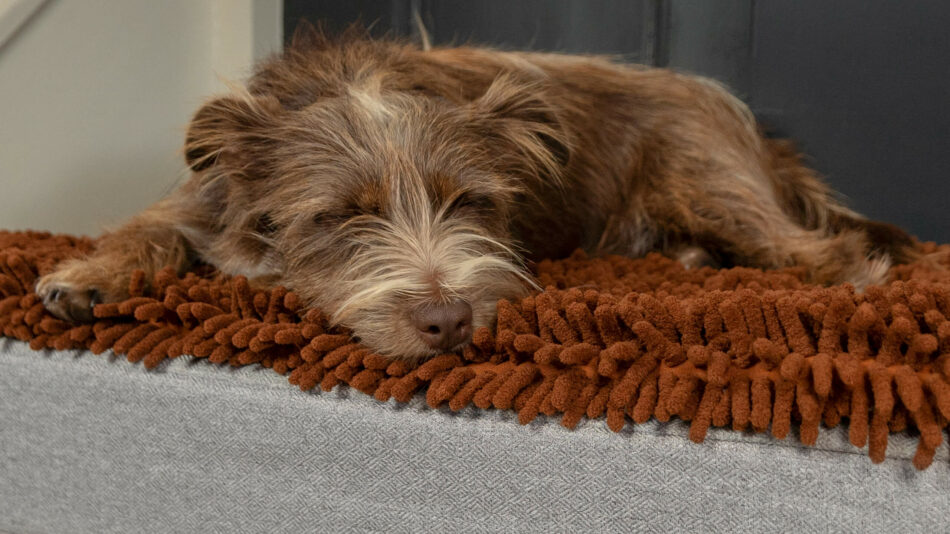

This entry was posted in Dogs
Bringing home a puppy is one of the most exciting moments in a dog lover’s life. But the first few months with a puppy can also be a whirlwind of joy, chaos, and learning. From endless puppy cuddles to the not-so-glamorous potty training, these early days are full of surprises. Join us as we explore what to expect, tips for success, and how Omlet products can help you and your puppy have a smooth start.
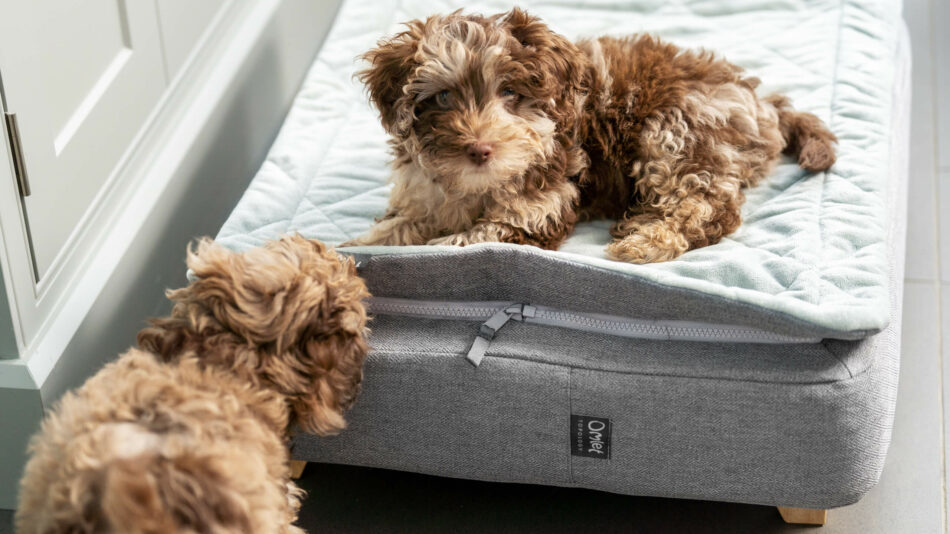
What you need to know about puppies
They have endless energy
Puppies are a bundle of energy that can keep you on your toes. If you’re expecting a little ball of fur to lie at your feet all day, you might be surprised by their boundless enthusiasm. Puppies need a lot of exercise, and without it, they can become restless and destructive. So in the first few months with your new puppy you’ll want to prepare for frequent walks, playtime, and interactive dog toys to help them burn off energy.
Teething pains are real
Teething is a challenging phase for both puppies and their owners. As their teeth come in, puppies experience discomfort and will chew on anything to relieve the pain. This stage can last for several months, and it’s essential to have appropriate chew toys and teething solutions on hand to prevent them from destroying furniture, shoes, or other valuable items. A durable dog bed will also be in order to ensure your puppy’s sleeping quarters don’t become their chewing station.
Socialization is crucial
One key aspect of raising a puppy is socialization. During the first few months, puppies are more open to new experiences and people. This is the prime time to introduce them to a variety of environments, people, and other animals to ensure they grow up to be well-adjusted adults. Without proper socialization, they might develop fear-based behaviors or aggression. Just be sure to always consult first with your vet to make sure your new pup is up to date on necessary vaccinations and is allowed to be around other dogs
Training should start early
Training is another critical component of a puppy’s early development. The sooner you start, the easier it will be to teach them good behavior and basic commands. Early training not only helps with obedience but also strengthens the bond between you and your puppy. Consider starting with simple commands like sit, stay, and come. Consistency is key, so make training sessions short and fun.
Puppy love
One of the best parts of having a puppy is the sheer cuteness they bring into your life. Those big puppy eyes, tiny paws, and playful antics can melt anyone’s heart. You’ll find yourself taking endless photos and videos to capture every adorable moment. Puppies have a way of making even the most mundane activities feel special.
And it’s likely that cuteness overload that creates such a strong initial bond between you and your new pup. As you care for them, play with them, and train them, you’ll develop a unique connection that grows stronger over time. Puppies are incredibly loyal and affectionate, and the first few months are the perfect opportunity to create a lasting relationship.
Things to avoid to prevent bad habits
One of the biggest mistakes new puppy owners make is inconsistent training. If you’re not consistent with commands, rules, and rewards, your puppy will become confused and struggle to learn. It’s essential to establish a routine early on and stick to it. Avoid mixed signals and ensure everyone in your household follows the same guidelines.
And because these small bundles of fur are so cute, it’s easy to let things slide. However, improper puppy training can lead to problems down the road that will be harder to correct as an adult dog. Allowing bad behaviors like jumping on people, nipping, or chewing on inappropriate items can become ingrained habits. Nip these behaviors in the bud by redirecting their energy and providing positive reinforcement for good behavior.
Puppy products to the rescue
Omlet offers a range of products designed to make the first few months with a puppy as smooth as possible. These items can help with training, comfort, and keeping your puppy entertained. Here’s a look at some of our top products:
Topology Dog Bed: Let’s face it, puppies have lots of accidents – it’s part of their process. So you need a bed that’s easy to clean and handle the wear. That’s where the Topology dog bed comes on. This dog bed features easy-to-wash covers, making cleanup a breeze when your puppy has accidents or gets dirty. And the covers are so durable that even sharp puppy teeth are no match.
Fido Nook Dog House: Being a puppy is a tough job. Everything is new and the first few months can feel overwhelming. That’s why having a secluded safe spot for your puppy to retreat to is essential for their well-being and development. The Fido Nook Dog House is a comfortable and stylish crate that’s perfect for training and providing a safe space for your puppy and give them their own space in adult life. Bonus – it will double as a piece of modern furniture in your home.
Omlet Dog Blankets: One of the best ways to offer your puppy comfort and calm is with a soft, snuggly blanket. The Omlet dog blankets offer coziness and warmth for your puppy, whether they’re snuggling in their crate or lounging on the sofa. Try wrapping the dog blanket around you before placing it in your puppy’s crate so they have a familiar scent to help soothe them when you are away.
Omlet Dog Toys: Just like toddlers, puppies love to play. So what better way to engage your little furball’s senses than with interactive and engaging dog toys. Omlet offers a wide variety of toy options to help keep your puppy entertained and can also be useful for training and socialization.
Omlet and your dog
Omlet understands that raising a puppy is both rewarding and challenging. That’s why we’re dedicated to creating products that make owning a puppy as enjoyable and stress-free as possible. By focusing on what makes the relationship between people and pets special, Omlet continues to design innovative solutions that support you and your puppy, from those first few months, through their senior years. With products such as our easy-to-clean dog beds and interactive dog toys, coupled with a little patience, you’ll find that having a puppy is one of the most delightful experiences you could wish for.
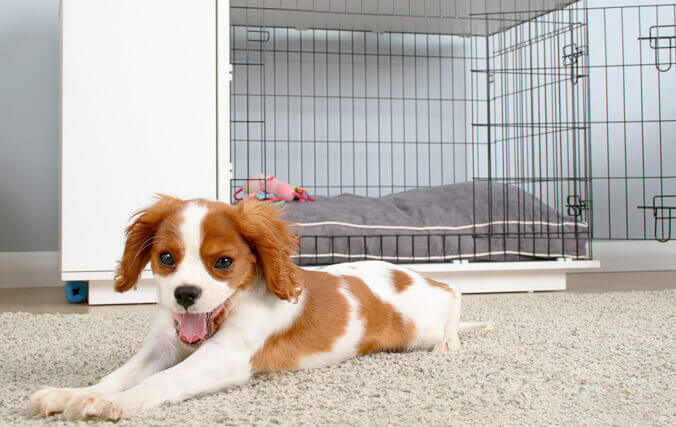

This entry was posted in Dogs
Training your dog can sometimes feel like you’re navigating through a maze without a map. However, with the right approach and understanding, it can transform into an enriching experience for both you and your canine companion. Whether you’re teaching basic commands or refining behavioral issues, these top seven dog training tips will set you on the path to success. From puppies to seniors, these tips are universally applicable, fostering a strong bond between you and your beloved pet.
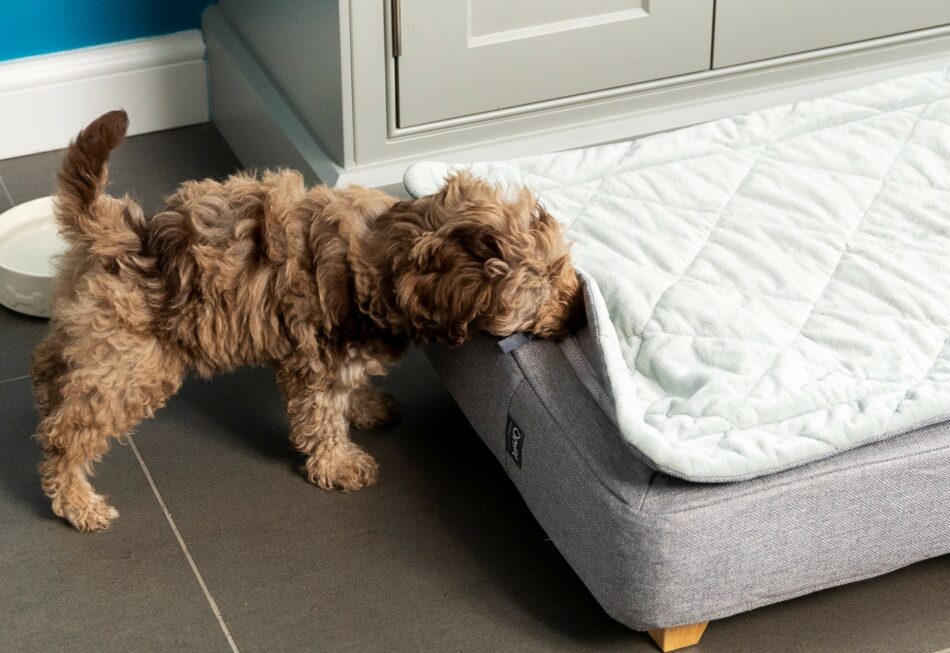
Consistency is key
Consistency is the cornerstone of effective dog training, much like the steady rhythm of a heartbeat. Dogs thrive on routine and predictability, and it’s through consistent actions and expectations that they learn best. So whether you’re teaching basic commands like sit and stay or more complex behaviors, such as walking on a dog leash without pulling, maintaining a consistent approach is paramount.
To achieve consistency in dog training, consider establishing a set schedule for training sessions. Just like how we mark our calendars for important events, setting aside dedicated time each day for training reinforces the routine for both you and your pup. Additionally, use consistent verbal cues and hand signals for commands, ensuring clarity in communication. Dogs are brilliant at picking up patterns, so sticking to the same cues for desired behaviors helps solidify their understanding.
Moreover, consistency extends beyond formal training sessions—it’s about applying the rules consistently in all interactions. Whether it’s not allowing your dog on the couch or insisting on sitting before meals, enforcing these boundaries consistently reinforces the desired behavior. Think of it as setting the stage for your dog’s success by creating a reliable framework within which they can thrive and learn.
Positive reinforcement
Positive reinforcement is the gold standard in modern dog training. With this essential component, it’s all about highlighting the good stuff – the behaviors you want to see more of – with rewards that make your dog’s tail wag with delight. Think of it as a canine high-five for a job well done. So, when your furry friend nails that perfect sit or finally masters the art of fetch without chasing squirrels halfway across the park, whip out their favorite dog treats and shower them with praise.
However, in a recent interview with Kieren Beckles, co-founder and editor of helloBARK! And LifeWithKleeKai, he described how food and treats don’t always work as motivators for all dogs. Speaking about his two Alaskan Klee Kai dogs, Kieran said, “We had different experiences training Copper and Skye. Skye isn’t food motivated so it required a lot of repetition and positive reinforcement. Copper is food motivated but easily distracted so we used treats and repetition.”
So positive reinforcement is not just about the treats. Sure, those tasty morsels work wonders, but it’s also about showering your pup with praise, scratches behind the ears, and maybe even a goofy victory dance. Dogs thrive on love and attention, and when they associate good behavior with all these good vibes, they’re bound to repeat it. When it comes to positive reinforcement, precision and timing are key. So make sure to dish out those rewards pronto, right when your dog performs the desired behavior.
Patience pays off
Patience is not just a virtue; it’s the secret sauce in successful dog training. Much like us humans, our furry companions need time to understand, learn, and adapt to new behaviors. Rushing the process often leads to frustration for both the trainer and the pup. So when it comes to dog training, take a deep breath, and embrace the power of patience. As Kieran from helloBARK! says, “training is a way to connect to them (dogs) on a deeper level and understand their individual needs.”
It’s easy to get frustrated when your dog doesn’t grasp a command right away, but patience and persistence are your best allies. Break down each training task into manageable steps, rewarding incremental progress. Remember, Rome wasn’t built in a day, and neither are well-trained dogs. So celebrate small victories along the way. Whether it takes a few weeks or a few months, trust that your patience will pay off in the form of a well-behaved and happy dog by your side.
Clear communication
Effective communication is vital in any relationship, including the one you share with your dog. Dogs rely on body language, tone of voice, and verbal cues to interpret commands and expectations. So when you’re doing any type of training with your dog, use clear and concise commands, accompanied by corresponding gestures or signals. And keep your body language open and inviting to convey confidence and authority without intimidation.
For instance, when teaching your pup to sit, pair the verbal cue “sit” with a hand signal—a raised palm works wonders. Consistency is key; ensure everyone interacting with your dog uses the same cues and signals to avoid confusion. Remember, dogs don’t understand human language but can pick up on tone and body language effortlessly, so by keeping your signals clear and your demeanor positive you will better engage them in the training.
Mental stimulation
When it comes to dog training, mental stimulation is just as important as physical exercise. Much like humans, dogs need mental challenges to keep their minds sharp and engaged. Incorporating mental stimulation into your training routine not only prevents boredom but also strengthens the bond between you and your furry friend. Try incorporating puzzle toys or interactive dog toy games into your training regimen. These not only provide mental stimulation but also give your pup a chance to problem-solve and work out their cognitive muscles.
Another effective way to provide mental stimulation is through scent work. Dogs have an incredible sense of smell, and tapping into this natural ability can provide hours of entertainment. Hide dog treats around the house or in the backyard and encourage your dog to sniff them out. This not only engages their mind but also taps into their instinctual behaviors. By incorporating mental stimulation into your dog’s training routine, you’ll not only keep them mentally sharp but also strengthen your bond and have a happier, more well-rounded pup.
Socialization
Socialization plays a pivotal role in dog training, much like how meeting new people broadens our horizons. Dogs thrive on interaction and exposure to various environments, sounds, and stimuli from an early age. So introducing your furry friend to a spectrum of experiences in a positive and controlled manner lays the groundwork for a well-adjusted and confident companion. Whether it’s a bustling city street or a tranquil park, each encounter shapes your dog’s understanding of the world, fostering adaptability and reducing anxiety in unfamiliar situations.
Ideally you want to start socializing your pup when they are around three to fourteen weeks old, which is when they’re most receptive to new experiences. But no matter what age your dog is, keep all new interactions positive by pairing new encounters with treats, praise, and gentle encouragement. Kieran from helloBARK! advises, “While new dog owners might consider basic commands such as sit, lie down, stay and heel which are all important, I would encourage owners to do research about the dog they’re adopting, whether it’s purebred, mix or a rescue. Think outside the box!” It’s all about building positive associations and turning potentially scary situations into delightful discoveries.
Seek professional help when needed
Embarking on the journey of dog training can be both rewarding and challenging. Sometimes, despite our best efforts, our dogs may exhibit behaviors that leave us scratching our heads. This is where seeking professional dog training help can make all the difference. Whether it’s mastering basic commands or addressing more complex behavioral issues, a skilled trainer can provide guidance tailored to your pup’s needs. Don’t be hesitant to reach out for assistance; after all, even the most experienced dog owners can benefit from a fresh perspective.
When selecting a professional trainer, consider their qualifications and methods. Look for certifications or memberships in reputable organizations, as these indicate a commitment to ongoing education and ethical training practices. Additionally, inquire about their approach to training. Positive reinforcement techniques, which reward desired behaviors, are widely regarded as the most effective in any dog training. Remember, the goal is to build trust and cooperation, fostering a strong relationship built on mutual respect.
Omlet and your dog
At Omlet, we understand the profound connection between pet parents and their dogs. That’s why we’re dedicated to creating innovative products that enhance the training experience for everyone involved. From interactive dog toys to stylish designer dog beds, we celebrate the wonder of sharing your space and life with your pet, and the joy of nurturing well-behaved, happy dogs. Embrace the journey of training your canine companion with patience, positivity, and the right tools, and watch your bond flourish into something truly extraordinary.
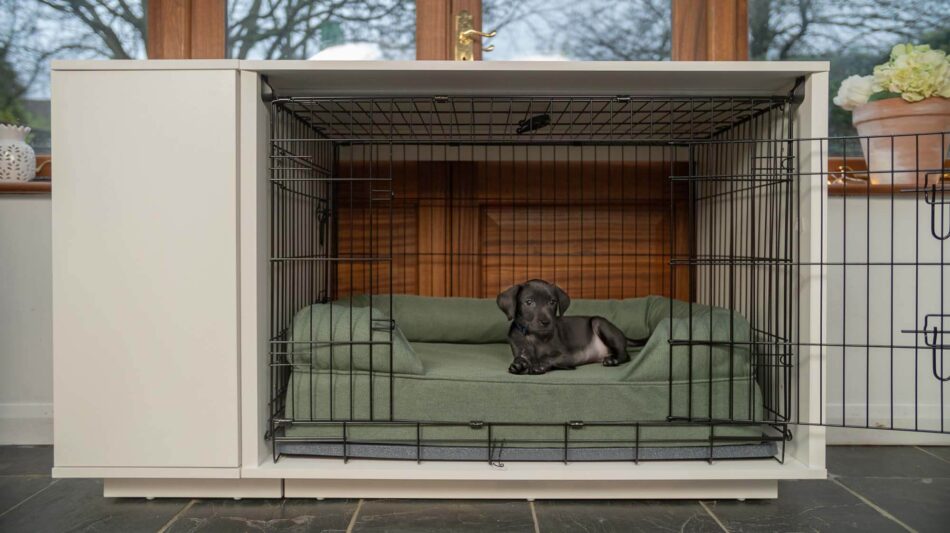

This entry was posted in Dogs
Whether you’re eagerly awaiting the arrival of a new puppy or opening your heart and home to a rescue dog, the decision to bring a canine companion into your life marks the beginning of an exciting journey. When adding another furry member to your family, you need to ensure you’re equipped with the right essentials to provide a comfortable and loving environment for your new best friend. In this blog, we’ll walk you through a comprehensive new dog checklist covering everything you’ll need to consider when welcoming a new canine companion into your life.
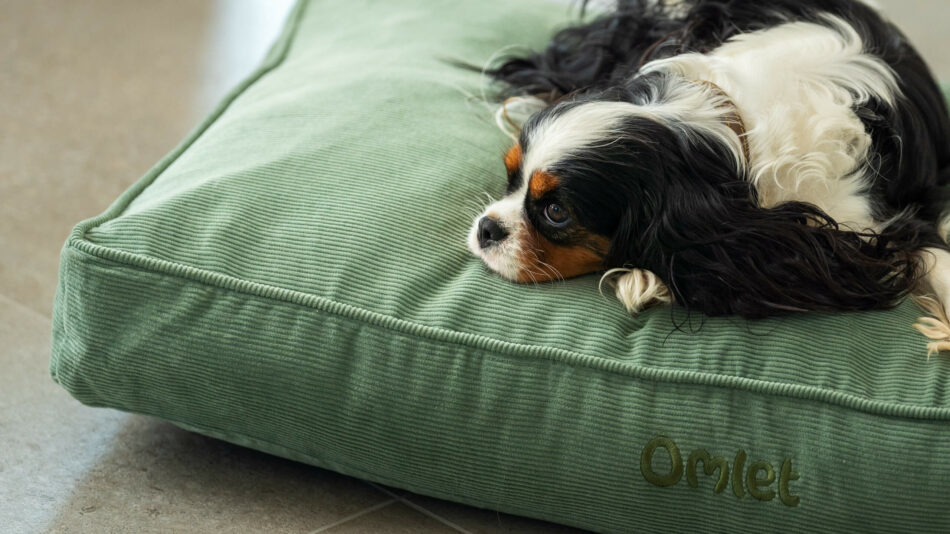
Dog beds
One of the first items to consider when welcoming a new furry friend into your home is a cozy spot for your dog to rest and relax. Enter the world of dog beds, where comfort meets functionality in a variety of shapes and sizes to suit every pup’s needs. Whether you opt for a plush cushion, an orthopedic mattress, or a durable outdoor bed, choosing a bed that suits your dog’s size, age, and sleeping habits is essential. Be sure to consider factors such as washability, durability, and support to ensure your pup gets a good night’s sleep.
Omlet’s Topology dog beds stand out for their customizable design, allowing you to create the perfect sleeping space tailored to your dog’s preferences. With interchangeable toppers of varying style and design, you can adjust the bed’s configuration to accommodate your dog’s sleeping habits. These beds not only provide orthopedic support for joint health but also boast durable and washable materials, ensuring long-lasting comfort for your canine companion.
For the dog owner on the go, Omlet offers the ultimate solution with their Cushion dog beds, designed for easy transport and versatility. Whether you’re embarking on a weekend getaway or simply heading to the park for a picnic, these go-anywhere beds provide a familiar and cozy spot for your dog to relax wherever your adventures take you. With a waterproof base and soft, plush cushioning, the Omlet Cushion dog beds offer both comfort and convenience in one compact package.
And let’s not forget the comforting embrace of Omlet’s Bolster dog beds, providing a sense of security and support for dogs who love to snuggle up against the raised edges. Made from premium materials and available in a range of stylish colors, these beds add a touch of luxury to your dog’s sleeping quarters while promoting a sense of well-being and contentment.
Dog crates
Dog crates are an indispensable addition to any new dog checklist, offering numerous benefits that contribute to the well-being and training of your furry companion. Beyond being a safe and secure space for your dog to rest, crates serve as valuable tools for house training and behavior management. By providing a designated “zen den” for your dog, you offer them a sanctuary where they can retreat when they need downtime or simply want to feel secure. This sense of ownership over their own space can help alleviate anxiety and stress, especially during times of transition or when faced with unfamiliar environments. Moreover, crates facilitate transportation, whether it’s a trip to the vet or a family vacation, ensuring your dog travels comfortably and securely while reducing the risk of escape or injury.
Investing in a quality dog crate is akin to providing your furry friend with their own personal haven within your home. When selecting a crate, consider factors such as size, material, and accessibility to ensure it meets your dog’s needs and complements your lifestyle. With proper introduction and positive reinforcement, your dog will come to view their crate as a safe haven rather than a confinement, fostering a sense of security and contentment. Ultimately, integrating a crate into your new dog’s routine not only aids in training and management but also strengthens the bond between you and your canine companion, laying the foundation for a harmonious and fulfilling relationship.
Dog leashes/collars
When it comes to essentials for your new furry friend, dog leashes and collars are at the top of the list. Think of them as the keys to unlocking adventures and ensuring safety during daily walks. A sturdy leash and well-fitted collar not only provide you with control and peace of mind but also give your dog the freedom to explore their surroundings safely.
But it’s not just about functionality; choosing the perfect leash and collar can also reflect your dog’s personality and style. Whether you opt for a vibrant patterned collar to showcase your pup’s playful side or a sleek, minimalist leash for a touch of sophistication, these accessories can add a dash of flair to your walks together. With the right leash and collar, you’re not just taking your dog for a walk—you’re making a fashion statement while strengthening your bond with your furry companion.
Dog bowls
When it comes to welcoming a new dog into your home, dog bowls are absolute essentials that should not be overlooked. These crucial items provide your dog access to fresh water and nutritious meals throughout the day. So investing in high-quality dog bowls not only ensures your dog’s basic needs are met but also promotes proper hydration and digestion, contributing to their overall well-being.
Whether you opt for stainless steel, ceramic, or melamine dog bowls, choose ones that are tailored to your dog’s size and eating habits in order to foster a positive dining experience for your canine companion. With sleek, modern designs and stylish shades, there’s a dog bowl to suit every taste and décor preference.
Dog accessories
When it comes to preparing for a new dog, accessories play a vital role in ensuring their comfort and well-being. Dog blankets are not just cozy additions to their sleeping area; they offer a sense of security and warmth, much like a comforting hug. Whether it’s a plush fleece blanket for snuggling on chilly nights or a waterproof option for outdoor adventures, having a few blankets on hand provides your furry friend with a familiar and inviting space to rest and relax. Plus, let’s be honest, who doesn’t love wrapping their pup up in a soft blanket for some extra cuddles?
Similarly, dog cooling mats are absolute game-changers, especially during the hot summer months. These innovative accessories offer relief from the sweltering heat, providing a cool surface for your dog to lounge on and escape the rising temperatures. Whether placed indoors or outdoors, cooling mats help prevent overheating and ensure your pup stays comfortable and refreshed, even on the hottest of days. So, don’t forget to add these essentials to your new dog checklist – because every pup deserves to be pampered with the best in comfort and relaxation.
Dog toys
Just like humans, dogs need outlets for their energy and natural instincts, and dog toys provide the perfect solution. From plush squeaky toys to durable chew bones and interactive puzzle feeders, the variety of toys available caters to different breeds, sizes, and play styles. Dog toys not only keep your dog occupied and entertained but also help prevent boredom and alleviate stress, especially during periods of alone time or when left at home.
Additionally, interactive dog toys that dispense treats or require problem-solving skills can challenge your dog’s cognitive abilities, keeping their mind sharp and engaged. By including a selection of toys in your dog’s environment, you’re not just providing entertainment – you’re promoting overall well-being and enriching their quality of life.
Furthermore, dog toys play a significant role in strengthening the bond between you and your furry friend. Engaging in playtime activities together fosters trust, communication, and companionship, creating lasting memories and deepening your connection. Whether it’s a game of fetch in the backyard, a tug-of-war session indoors, or a relaxing chew session on the couch, these shared experiences strengthen the bond between you and your dog, building a foundation of love and mutual understanding.
Omlet and your dog
As you prepare to welcome a new dog into your life, remember that each pup is unique, with their own set of needs and preferences. By equipping yourself with the right essentials and taking the time to understand your dog’s behavior and personality, you’ll be well on your way to building a strong bond and creating lasting memories together. At Omlet, we believe in asking the right questions to understand how to invent products that enhance the lives of both pets and their parents. From innovative dog crates to cozy dog beds and interactive dog toys, we’re dedicated to making life better for pets and pet owners alike and bringing the adventures with your new furry friend one step closer.
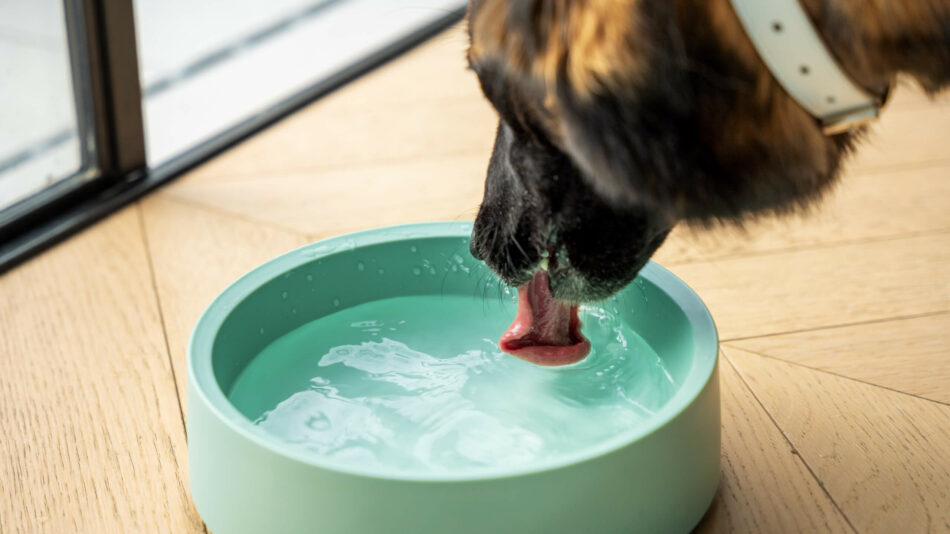

This entry was posted in Dogs
Welcoming a furry friend into your home is an exciting decision, but how do you know the right dog to bring that into your family? With countless breeds to choose from, finding the perfect match can seem daunting. However, understanding the different breed types and their characteristics can guide you towards a companion that complements your family dynamics as well as your lifestyle and preferences. From energetic outdoor adventurers to cuddly couch companions, there’s a dog breed suited for every household.
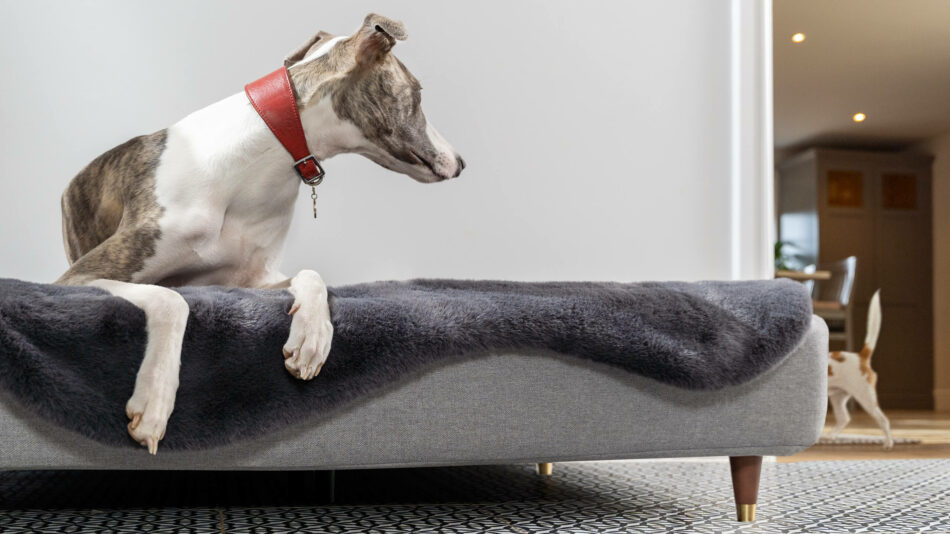
Hound breeds
Hound dogs are the quintessential embodiment of loyalty, charm, and an insatiable zest for adventure. With their characteristic droopy ears and soulful eyes, these four-legged friends bring a unique blend of affection and curiosity to any household lucky enough to welcome them in. Examples of dogs in this breed include the beagle, bloodhound, and greyhound. Renowned for their keen sense of smell and unwavering determination, hounds have historically been prized as hunting companions. However, their gentle demeanor and unwavering loyalty make them equally cherished as beloved family pets.
When considering adding a hound dog to your family, it’s important to understand their personality traits and the lifestyle they thrive in. These pups are known for their independent streaks, often following their noses wherever it leads them. This means they may not always be the most obedient of companions, but their playful antics and boundless enthusiasm more than make up for it. Hounds are social creatures who revel in the company of their human pack, making them ideal for families who enjoy spending time outdoors and engaging in activities that stimulate their curious minds.
Whether it’s a leisurely hike through the woods or a lively game of fetch in the backyard, hound dogs thrive in environments where they can explore and unleash their natural instincts. So, if your family is seeking a loyal and adventurous companion to join in your escapades and add a touch of excitement to your everyday life, a hound dog might just be the perfect fit for you.
Working breeds
Working dog breeds encompass a diverse group known for their intelligence, loyalty, and strong work ethic. From the energetic Australian Cattle Dog to the steadfast bernese mountain dog, each breed brings unique qualities shaped by their historical roles alongside humans. These breeds thrive on mental and physical stimulation, often requiring purposeful activities to channel their boundless energy. Families seeking a companion that doubles as a partner in adventure and exploration will find an ideal match within this dynamic group. Their unwavering dedication makes them invaluable additions to households willing to provide ample outlets for their natural instincts.
Understanding the nuances of working dog breeds is crucial when determining their compatibility with different family dynamics. For active households with an outdoor lifestyle, breeds like the anatolian shepherd dog or the Siberian Husky are well-suited companions, excelling in activities like hiking, running, or even dog sports. But before welcoming any working dog breed into your home, first assess your family’s lifestyle, commitment to training, and available space. Potential owners of this breed should also consider factors like grooming needs, shedding, and potential health concerns associated with these dogs to ensure a harmonious match for both family and furry friend.
Toy breeds
Toy dog breeds encompass a delightful array of pint-sized pooches, each packed with personality and charm. From the spunky chihuahua to the regal pomeranian, these compact canines offer big love in small packages. Their petite stature makes them perfect companions for various types of families, but understanding their unique traits is key to finding the best fit.
For families seeking cuddly companionship and low-maintenance care, toy breeds like the affectionate Cavalier King Charles Spaniel or the gentle Maltese might be ideal. These breeds thrive on human affection and are often content to curl up on the couch with their loved ones, making them perfect for families with children or seniors looking for devoted companionship.
Sporting breeds
If you have a bustling household that is filled with laughter, play, and endless adventures then you have the perfect setting for a sporting dog breed. These furry athletes are like the MVPs of the dog world, ready to join in on any family fun with their boundless energy and unwavering loyalty. Whether you’re a thrill-seeking clan that loves hiking through rugged trails or a laid-back crew content with leisurely strolls in the park, there’s a sporting dog breed tailor-made for your unique vibe.
The labrador retriever, otherwise known as the social butterfly of the group, is always up for a game of fetch or a dip in the nearest body of water. Their friendly demeanor and eagerness to please makes them the perfect companions for families who crave constant companionship and plenty of outdoor activities. Then there’s the adventurous Brittany, a pint-sized powerhouse bursting with enthusiasm and intelligence. So whether you’re a high-energy household or a laid-back bunch, there’s a sporting dog breed out there waiting to become your family’s four-legged best friend.
Terrier breeds
Terriers, with their spunky personalities and boundless energy, are a spirited bunch that brings a whole lot of character into any home. From the feisty jack russell terrier to the tenacious Scottish Terrier, these small to medium sized powerhouses pack a punch of personality. Terriers are known for their intelligence, determination, and fearlessness, making them perfect companions for families who thrive on excitement and adventure. If you’re looking for a dog that’s always up for a challenge and eager to explore the world alongside you, a terrier might just be your perfect match.
When considering a terrier for your family, it’s essential to understand their unique traits and how they align with your lifestyle. Terriers are often best suited for active families who can keep up with their high energy levels and provide plenty of mental and physical stimulation. But their natural hunting instincts and strong prey drive mean they may not be the best fit for households with small pets like cats or rabbits. However, for families who enjoy outdoor activities, games, and interactive training sessions, terriers can be incredibly rewarding companions.

Herding breeds
From the iconic border collie to the spirited Australian Shepherd, the herding dog breeds excel at managing and controlling livestock with their innate herding instincts. Known for their intelligence, loyalty, and remarkable work ethic, these dogs thrive in environments where they have a job to do or tasks to accomplish.
But beyond their herding prowess, herding dogs make fantastic companions for families who appreciate their sharp minds and unwavering devotion. If you’re a family with an active lifestyle and enjoy engaging your furry friend in stimulating activities, a herding dog could be your perfect match. With the ability to adapt to various living situations, herding dogs can bring endless joy, companionship, and a touch of adventure to your home.
Non-sporting breeds
The non-sporting dog breed group is a colorful collection of canines with a wide range of personalities and temperaments. From the dignified bulldog to the lively poodle, each dog in this breed brings its own unique charm to the table. While they may not all share a common purpose like hunting or herding, non-sporting dogs make up for it with their diverse array of traits and adaptability.
For families seeking a four-legged friend that fits seamlessly into their lifestyle, understanding the personality traits of non-sporting breeds is key to finding the perfect match. Whether you’re a family that likes a cozy night in and leisurely strolls around the neighborhood or are a household of many children that are actively on the go, you’re sure to find a non-sporting dog that will complement your clan. These dogs thrive on companionship and are content to snuggle up on the couch with their favorite humans.
Rescue dog vs. puppy: The debate
When considering adding any dog of any breed to your family, the decision between adopting a rescue dog or bringing home a puppy is typically the next significant consideration. Rescue dogs offer the opportunity to provide a loving home to a dog in need while puppies allow families to shape their companion’s upbringing from the beginning.
Pros of rescue dogs:
- Rescue dogs often come with established personalities and behaviors, making it easier to assess compatibility.
- Adopting a rescue dog gives them a second chance at a loving home, providing a rewarding experience for the entire family.
- Many rescue organizations provide support and resources to ensure a successful transition for both the dog and the family.
Cons of rescue dogs:
- Rescue dogs may come with unknown backgrounds or behavioral issues that require patience and training to address.
- It may take time for a rescue dog to adjust to their new environment and form bonds with their new family members.
- Certain rescue dogs may have medical or behavioral issues that require ongoing care and attention.
Pros of puppies:
- Bringing home a puppy allows families to shape their companion’s behavior and training from a young age.
- Puppies provide an opportunity for families to bond and create lasting memories as they grow together.
- Puppies typically have fewer health and behavioral issues compared to some rescue dogs.
Cons of puppies:
- Raising a puppy requires time, patience, and commitment to proper training and socialization.
- Puppies go through various developmental stages, including teething and housebreaking, which can be challenging for first-time dog owners.
- The initial costs of vaccinations, spaying/neutering, and supplies can add up quickly.
Omlet and your dog
Choosing the right dog for your family is a significant decision that requires careful consideration of various factors, including breed characteristics, lifestyle, and preferences. At Omlet, we understand the importance of this decision and strive to create innovative pet products that enhance the bond between pets and their owners. From cozy dog beds to interactive dog toys, we’re here to support you on your journey to a fulfilling and enriching companionship with your dog and celebrate the wonder of your bond together.
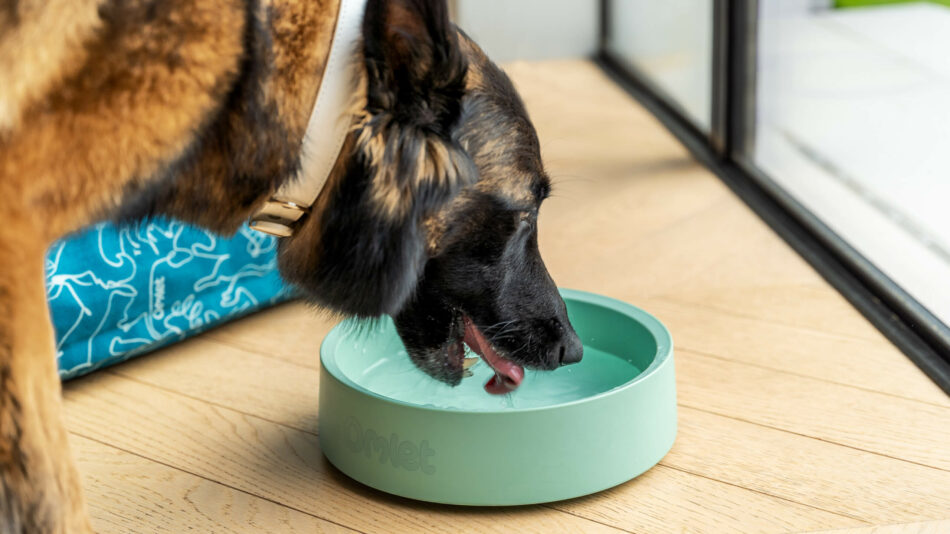

This entry was posted in Dogs
Keeping your furry friend active is essential for their physical health and mental well-being. While walks around the block are great, sometimes you and your dog need a little variety in your exercise routine. That’s where these 7 different and fun exercise ideas for your dog come in handy. Whether rain or shine, indoor or outdoor, there’s something here for every pup, and human, to enjoy.
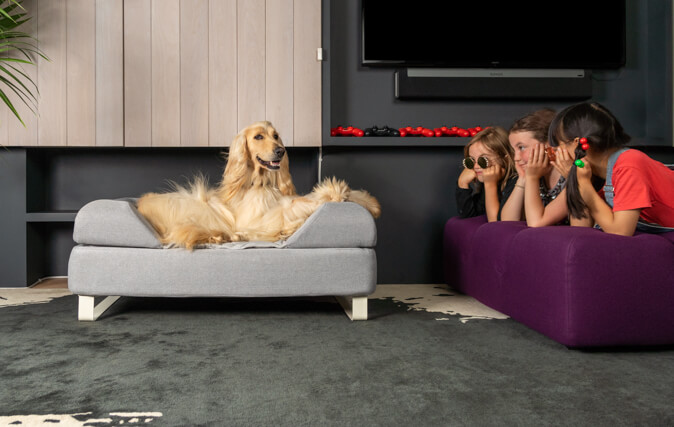
Outdoor adventure walks
Take your routine walks around the neighborhood up a notch by seeking out new adventure walks. Yes, dogs like routine, but they also like new smells and experiences too. So instead of sticking to the same old path, try exploring new trails, parks, or nature reserves. An entire oasis of new sights and smells is ready for you and your dog to discover when you venture out into the wild.
Setting it up: Start by researching dog-friendly trails or parks in your area. You likely won’t have to drive too far to find some pretty cool new trails or parks to explore. Because you’ll be checking out new surroundings, be sure your dog is wearing their favorite dog collar and leash with proper identification. Bring water and snacks for both you and your pup and maybe even a travel-easy dog bed so they can rest well on the way home.
Why it’s good: Outdoor adventure walks provide loads of mental stimulation for your dog and allow them to engage with their natural instincts. Exploring new environments keeps a dog’s mind sharp and promotes overall happiness.
Fetch and retrieval games
Fetch is a classic game that never gets old and is a guaranteed way to exercise your dog. And the best part is it doesn’t take a lot of work to play this fun game together. Simply find an open space, like a backyard or a dog park, and let your dog chase after a ball or a frisbee. Retrieval games are not only fun but also great for improving your dog’s agility and coordination.
Setting it up: Choose a safe area that is free from obstacles or hazards. Be sure it’s a space that allows dogs to be off leash and is safe for them to be running free. Start with short throws of a ball, frisbee, or even their favorite dog toy and gradually increase the distance as your dog gets more comfortable. And don’t forget to bring a dog bowl with water as your dog will need to rehydrate often.
Why it’s good: Fetch and retrieval games are a great form of dog exercise as they provide excellent cardiovascular health for your dog while also strengthening their muscles. But perhaps the best part of a game of fetch is the bonding experience between you and your pup, which is priceless.
Outdoor agility course
Have you ever watched dog agility competitions on TV and wondered if your dog could be an obstacle pro as well? Only way to know is to try it. Agility courses are a fantastic way to challenge your dog both mentally and physically. And they can be as easy as setting up tunnels, jumps, and weaving poles in your backyard. You and your dog will love the fun that comes with an outdoor agility course and how rewarding it is for dogs of all ages and breeds.
Setting it up: When it comes to agility courses you don’t have to go straight out and purchase expensive agility equipment. You can use items around your house that are suitable for your dog’s size and skill level. Cardboard boxes, laundry baskets, and even your kid’s orange play cones are all perfect items that can help construct a beginner agility course. Start with basic obstacles and gradually introduce more advanced challenges as your dog gets the hang of it.
Why it’s good: Agility training is an excellent exercise for dogs as it improves their balance, coordination, and problem-solving skills. It also builds their confidence and strengthens the bond between the two of you.
Swimming sessions
If your dog loves the water, then swimming is an excellent full-body workout to incorporate into their exercise routine. But how do you know if your dog likes to swim? Start by finding a dog-friendly beach, lake, or pool where your pup can splash around safely to test the waters and see if they like it. Even if your dog doesn’t go all the way in for a full body dip, the act of running along the water will provide enough exercise. Swimming is especially beneficial for older dogs or those with joint issues.
Setting it up: If your dog has never swam before or if you are not sure they know how to swim, start by choosing a calm, shallow body of water to start. This will allow your dog to explore the possibility of swimming without too much commitment. And always be sure to have the right products when going for a doggie dip – consider a canine life jacket for added safety, a properly tagged dog collar, an old towel to rub them down and some dog treats to enjoy after a good splash will all make this experience more enjoyable.
Why it’s good: Swimming is a low-impact exercise that’s gentle on your dog’s joints. Your dog will receive a thorough workout without putting stress on their bones. But the best part? Swimming is a great way to beat the heat during hot summer months.
Indoor treat hunt
When the weather outside is too cold or rainy to explore an outdoor exercise, try setting up some workout routines inside. Indoor treat hunts are a fun way to keep your dog mentally stimulated while also getting them to move their bodies. And it can be as easy as hiding treats around the house and letting your dog use their nose to sniff them out.
Setting it up: The key to making an indoor treat hunt fun for your dog is to choose a variety of different hiding spots. This is your time to get creative. While your dog’s in another room, quietly hide dog treats under furniture, behind doors, or even inside their dog crate house. As your dog becomes efficient at finding the treats in the easy hiding spots, gradually increase the difficulty by choosing more challenging spots.
Why it’s good: Indoor treat hunts are a great way to engage your dog’s sense of smell and provide mental stimulation at the same time. Spending time “hunting” and sniffing will also help to prevent your dog’s boredom and destructive behavior.
Interactive toys and games
If there’s one exercise that is guaranteed to tire your dog out regardless of the weather, it’s playtime with you and their favorite interactive dog toys. Not only do toys and games keep your dog engaged, exercised, and entertained, they’re a great way to keep your furry friend challenged. Keep a variety of different toys and games such as puzzle toys, treat-dispensing balls, or interactive play mats so that your dog’s problem-solving skills can be challenged and elevated.
Setting it up: Too much of a good thing can often lead to overwhelm and that is true when it comes to dogs and toys. So set aside time each day to bring out one or two toys to play with your pup. If it’s a new toy, introduce it to your dog by itself so they can fully immerse themselves in the nuances of the new object. Every other week, try rotating the toys regularly to keep your dog’s interest piqued and their excitement engaged.
Why it’s good: Interactive dog toys and games are the perfect exercise tool for dogs as they provide mental stimulation and prevent boredom. If you live somewhere where the weather prohibits frequent outdoor play, dog toys are an essential in maintaining your dog’s physical health and mental well-being.
Indoor obstacle course
Who said obstacle courses are only for the great outdoors? When the weather isn’t cooperating for outdoor play, take the fun inside and create a DIY obstacle course. Again, no need to purchase any expensive agility equipment – simply use household items like chairs, cushions, and cardboard boxes to create the ultimate indoor dog adventure. Just be sure to designate a space in your home where your dog can navigate through tunnels, jump over hurdles, and weave between obstacles without hurting themselves or your furnishings.
Setting it up: Start by clearing a space in your home where you can set up the obstacle course safely. Choose a room that is big enough for your dog to navigate based on their size and remove any pieces of furniture or items that could cause them harm or get damaged in the process. When choosing items for the obstacle course, pick ones that are stable and won’t topple over easily – this is all about having fun, so make sure not to use anything that could cause injury or get broken.
Why it’s good: Indoor obstacle courses provide incredible physical exercise and increased mental stimulation for your dog as well. The repetitive sequencing of traversing the course reinforces obedience and agility skills, which are both excellent for your dog’s body and mind.
Omlet and your dog
No matter the weather, keeping your dog active and engaged is crucial for their overall well-being. Whether you’re exploring the great outdoors or getting creative with indoor activities, there’s no shortage of ways to keep your pup exercised and entertained. At Omlet, we understand the importance of movement for all pets which is why we offer a wide range of products designed to enhance your bond with your pet. From interactive dog toys to dog collars and leashes, we make the products your dog needs no matter what activity you’re engaging in. So get out there, have fun, and start exercising with your dog.
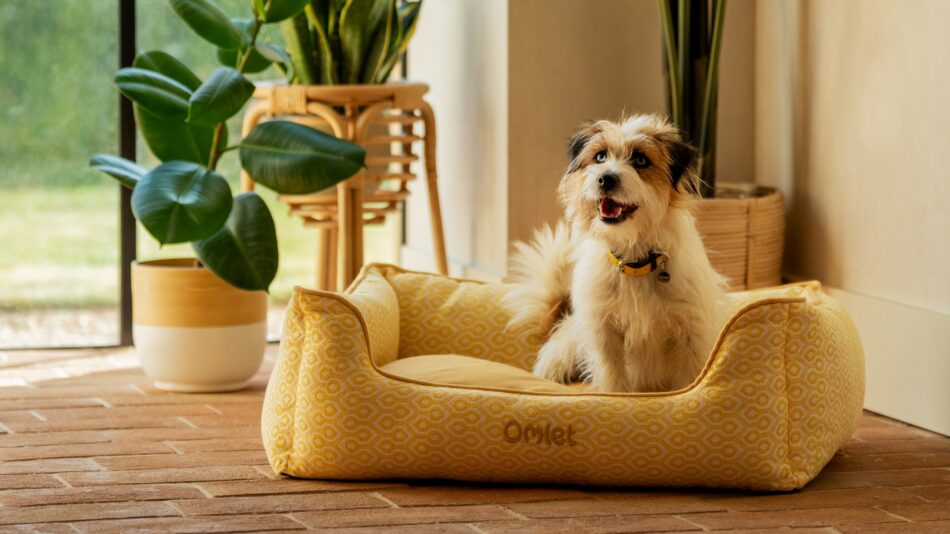

This entry was posted in Dogs
Ah, the simple joy of watching our furry companions curl up into a cozy ball and drift off into dreamland. For dog lovers, witnessing our canine friends catch some z’s is a delightful spectacle that never fails to warm our hearts. But did you know that behind those adorable snoozing poses lie a plethora of fascinating facts about dogs and their sleeping habits? Prepare to be intrigued as we delve into 7 things you didn’t know about dogs and sleep.
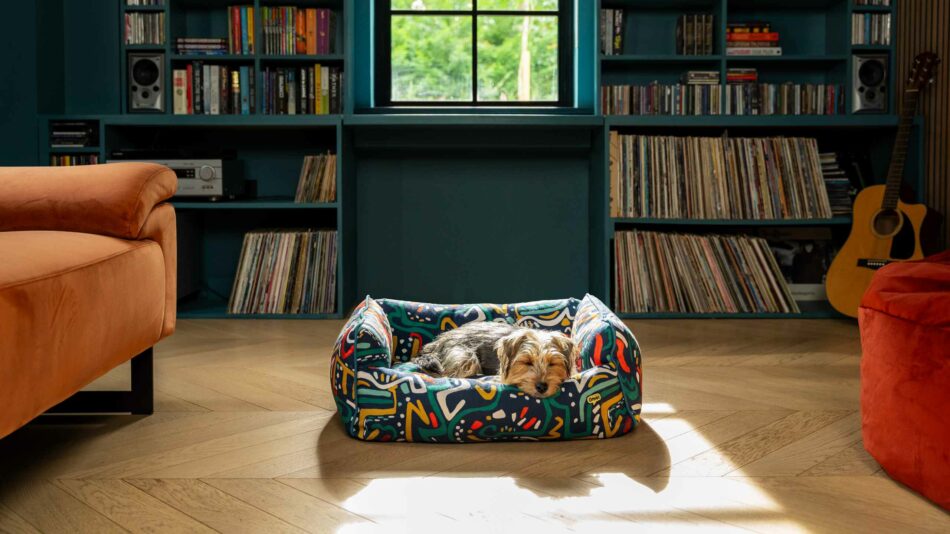
Dogs circle before bed:
Ever wonder why your dog makes a few rounds before finally settling down for the night? This seemingly quirky behavior actually has deep-rooted evolutionary significance. In the wild, dogs would circle to create a comfortable sleeping spot and to ensure safety from predators. It’s a natural instinct, ingrained in their DNA, to create a spot that is comfy for sleep but away from danger.
Even though our domestic pups may not face the same threats, their innate behavior remains a part of their makeup. You can cater to this ancestral need by making sure your dog has a comfortable and supportive dog bed that fits their size. Allowing your dog the opportunity to have a warm and cozy spot to sleep will ensure their primal and domestic needs are met.
Dogs do dream:
Have you ever noticed your dog twitching, whimpering, or even barking in their sleep, and wondered if they’re chasing all those squirrels they never quite catch in real life? Well the answer isn’t entirely clear cut.
Dogs do indeed dream; research suggests that dogs experience similar sleep patterns to humans, including the rapid eye movement (REM) stage where dreaming occurs. But while it’s confirmed that dogs do dream, the content of their dreams still remains a bit of a mystery.
Are they dreaming about playing with their toys, other dogs, or better yet, you? We may never know for sure. Our furry friends can’t spill the beans on their dreamland wonder but we like to think that their humans are never far from their subconscious adventures.
The meaning behind dog yawns:
You know how sometimes you just can’t help but let out a big yawn when you’re feeling sleepy or bored? Yawns are universally recognized as a sign of tiredness or boredom, but when it comes to dogs, there’s more to it than meets the eye. In humans, some yawning is a way of empathizing; we often yawn when others do, in a subconscious show of solidarity.
When dogs yawn, it can actually be a way for them to communicate with us and other dogs around them. It’s like their way of saying, “Hey, I’m feeling a bit stressed or anxious right now.” Just like humans, dogs can feel a range of emotions, and yawning is one of the ways they might express those feelings.
But dogs also yawn as a way to calm themselves down in tense situations. So if you notice your furry friend giving a big yawn during a training session or when meeting new people, it might not be because they’re bored or tired, but rather because they’re trying to soothe themselves. It’s their version of taking a deep breath to relax. So give your dog some space if you notice a big yawn and try to read their body language to see if they might need a little extra comfort or support.
Zoomies before z’s:
We’ve all witnessed the phenomenon of “zoomies”—those bursts of frenetic energy that seem to possess our dogs out of nowhere. Surprisingly, these spirited romps often occur just before bedtime. While it may seem counterintuitive, this behavior is believed to be a natural way for dogs to release excess energy before settling down for the night.
In the wild, dogs would spend their days hunting, exploring, and playing, so they’d naturally be pretty active. As the sun starts to set and night falls, their instincts kick in, telling them it’s time to find a safe spot to rest and recharge for the next day’s adventures. So, those pre-sleep zoomies are basically their way of mimicking that wild behavior, getting rid of any excess energy so they can sleep soundly through the night. It’s like their own little bedtime routine, complete with a sprint to the finish line before settling in for some well-deserved rest.
Paws up, eyes closed:
Ever notice how your furry friend sometimes snoozes with their paws flung up in the air like they just don’t care? It’s a common sight in the canine world, and there’s more to it than just striking a cute pose. Dogs often sleep with their paws in the air as a sign of relaxation and comfort. Just like we might sprawl out on the couch after a long day, our four-legged pals stretch out in all sorts of positions to unwind. With their paws up, they’re releasing tension in their muscles and letting their bodies sink into a state of blissful repose
But why exactly do they choose this particular position? When your dog plops down on their back with their paws in the air, they’re exposing their most vulnerable parts—like their belly—to the world. It might seem counterintuitive to us humans, but for dogs, it’s a sign of trust and security. By showing off their soft underbelly, they’re letting you know that they feel completely safe and at ease in their surroundings. It’s a testament to the bond between you and your furry companion.
Dogs have a third eyelid:
As dog owners, it’s natural for us humans to want to stare all day at our furry canine companions as they sleep. But sometimes, you may notice that one eye almost looks like it’s still open while the snores are still filling the room. Are they half awake? Nope. That’s just your dog’s third eyelid you’re seeing. Also known as the nictitating membrane, this translucent membrane serves as an extra layer of protection for a dog’s eyes. And it’s most commonly seen when they are in deep slumber.
While it may sound odd, this unique feature helps keep their eyes moist and shielded from debris. And it also acts as a trusty defender keeping your canine companion’s eyes squeaky clean. Think of it as a natural windshield wiper, sweeping away any gunk or goop that might try to cling onto those adorable puppy eyes. So, the next time you catch a glimpse of your dog’s third eyelid, remember, it’s just another fascinating aspect of their anatomy that makes them so wonderfully unique.
Dogs sleep for half their life:
It’s no secret that dogs love their beauty sleep, but just how much do they snooze? As it turns out, dogs spend approximately half of their lives sleeping. While the exact amount varies depending on factors like age and breed, it’s safe to say that our canine companions are true sleep enthusiasts. While your dog’s snooze sessions might seem excessive, they’ve actually got it all figured out.
While we humans often juggle hectic schedules and burn the candle at both ends, our four-legged companions show us the true meaning of balance. From chasing squirrels to playing fetch, dogs throw themselves into every activity with boundless enthusiasm and when it’s time to recharge, they do it. So make sure your furry friend has a comfy dog bed to catch all their z’s and maybe try relaxing with them the next time they have a nap.
Omlet and your dog
Understanding the intricacies of dogs and their sleep habits is just one way we can deepen our connection with our beloved pets. At Omlet, we recognize the importance of catering to every aspect of our dogs’ well-being, from their sleep to their playtime and beyond. That’s why we’re dedicated to crafting innovative products like customizable dog beds and meticulously engineered dog dens that enhance the lives of both dogs and their owners, ensuring they can spend more quality time resting by your side. Because when it comes to our furry friends, every moment shared, waking or sleeping, is truly precious.
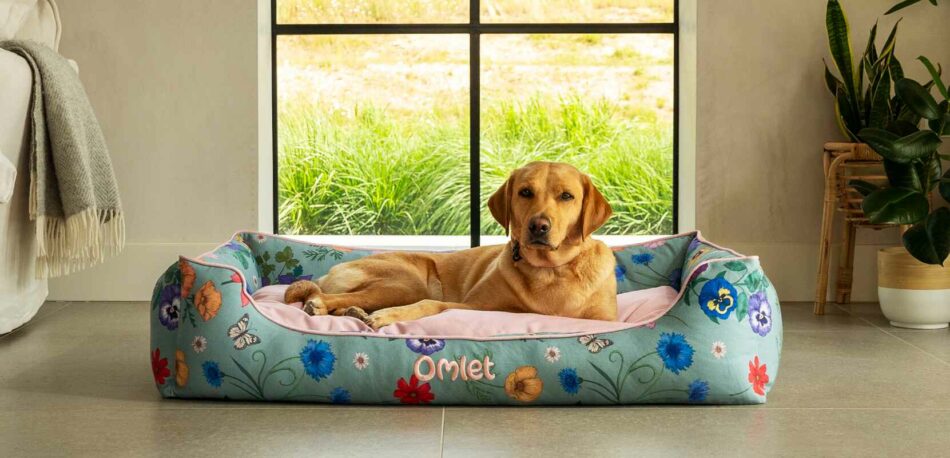

This entry was posted in Dogs
As pet owners, we cherish the moments when our furry companions snuggle up for a peaceful slumber. Yet, what happens when our beloved canine companions toss and turn, unable to find the rest they need? Understanding what is affecting your dog’s sleep is crucial for ensuring their well-being and happiness. Let’s delve into the intricacies of what might be keeping our pups up at night and explore effective solutions to promote their quality rest.
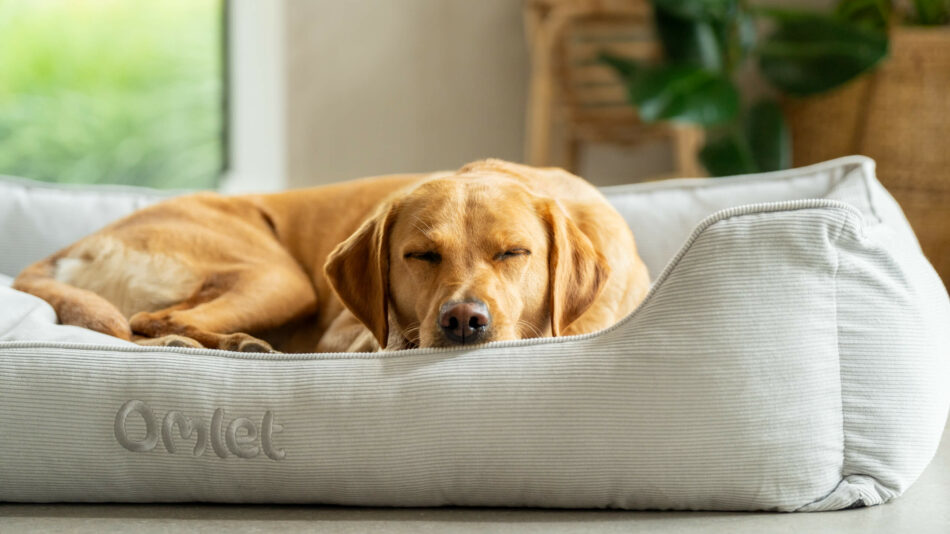
What could be affecting my dog’s sleep?
Ever wondered why your furry friend seems restless at bedtime? It could be anything from an unbalanced diet to a change in routine that throws off their sleep cycle and leaves them in need of some serious R&R. Here’s a look at some of the common factors that could be affecting your dog’s sleep.
Lack of exercise
Just like humans, dogs require regular physical activity to tire their bodies and minds. A lack of exercise can lead to pent-up energy, causing restlessness and difficulty in settling down for sleep. Daily walks, interactive play sessions, or engaging in stimulating activities tailored to your dog’s breed and age can significantly contribute to a more restful night’s sleep.
So grab your dog’s favorite leash and collar and make walking around the neighborhood a daily activity. Or make a game out of hide-and-go-seek their favorite dog toy. As soon as you notice your dog feeling unsettled in their nighttime routine, the fix could be as easy as incorporating more fido fitness.
Underlying health issues
If adding more exercise to your dog’s routine isn’t working, or their age has limited their activity, it may be time to look a little deeper into what might be impacting their sleepless nights. Undiagnosed health problems could be silently disrupting your dog’s sleep patterns.
Conditions such as arthritis, dental pain, or even anxiety disorders can interfere with a dog’s ability to find comfort and relaxation. So it’s important to stay on top of regular veterinary check-ups and pay prompt attention to any concerning symptoms. A healthy dog is a happy dog and happy dogs are more likely to get quality sleep.
Poor diet
Did you know nutrition plays a pivotal role in your dog’s overall well-being? That includes their sleep quality, too. Feeding your furry friend a balanced diet that is appropriate for their age, size, and activity level is crucial not only for their health, but their sleep quality. So if you notice your dog awake more during nighttime hours, it could be linked to diet.
Is someone in the house feeding from under the table when they aren’t supposed to? Is your dog eating too much or too little? Poor diet choices or food allergies can lead to gastrointestinal discomfort which could be keeping your dog awake. Be sure to consult with your veterinarian if you notice sleep issues that you think could be related to food, so you can be sure of feeding the most suitable diet for your dog.
Environmental factors
The environment in which your dog sleeps can significantly influence their ability to rest peacefully. Factors such as excessive noise, uncomfortable bedding, or extreme temperatures are all factors that can disrupt their sleep cycle. Creating a quiet, comfortable, and safe sleeping space for your dog that is away from disturbances promotes better sleep by creating a space dedicated to their relaxation.
Find a dog bed that suits your dog’s sleep preferences. The Topology dog bed designed by Omlet is an excellent choice as it allows you to choose from a variety of Toppers to find textures your dog likes best. You’ll find it hard to pick a favorite, as they’re all designed to zip on and off easily and go straight in the washing machine. Adding some dog feet to the bottom raises the bed off the ground, promoting better hygiene and air flow. To help nervous dogs feel more secure, you can also add a dog crate nook so your pup has a secure space to retreat to when they need a solid snooze.
The Omlet Bolster bed is another great option for promoting restful sleep. A memory foam mattress combined with a full body snuggling cushion, angled to comfortably support their head as they snooze, this is a bed built to compete with the couch.
Change in routine
Dogs love and depend on routine. Disruptions to their daily schedule can cause stress and anxiety which, in turn, can lead to sleep disturbances. So if you’ve noticed your dog’s sleep patterns changing or disruptions in their normal cycles, check if any of these factors are new:
Any one of these factors can cause your dog stress, which could ultimately impact their sleep. So if you do have any upcoming or new changes in your house, do your best to maintain consistency in their daily routine and gradually introduce the changes where possible, so you can help minimize stress and promote better sleep habits for your furry companion.
Ways to prevent or help
When it comes to addressing your dog’s sleep issues it’s best to take a multifaceted approach that is tailored to their specific needs. Use the list above as a guideline to ensure all needs are being met: is your dog getting regular exercise, are they maintaining a balanced diet, and do they have a peaceful sleeping environment? Once you have taken a proactive look at all these factors, there are some additional things you can do to help ensure your dog’s healthy sleep habits.
Try incorporating calming routines before bedtime, such as a gentle massage or soothing music. This can help relax your furry friend and prepare them for a restful night’s sleep – plus the bonding time together is an added bonus. And whenever in doubt, seek guidance from a veterinarian or animal behaviorist as they can provide valuable insights and personalized strategies to address your dog’s specific sleep-related concerns effectively.
Omlet and your dog
At Omlet, we understand the importance of catering to the diverse sleep patterns and needs of all dogs. That’s why we design beds to suit the ergonomics of dogs’ bodies and with durable, upholstery grade fabrics tested to withstand their needs to stretch, turn and roll. All our products are engineered with your pet’s comfort and well-being in mind, offering a range of innovative solutions that will give them the rest they deserve. From cozy dog beds to comforting zen doggie dens, we strive to enhance the sleep experience for all dogs, helping them wake up refreshed and ready for another day of adventures by your side.
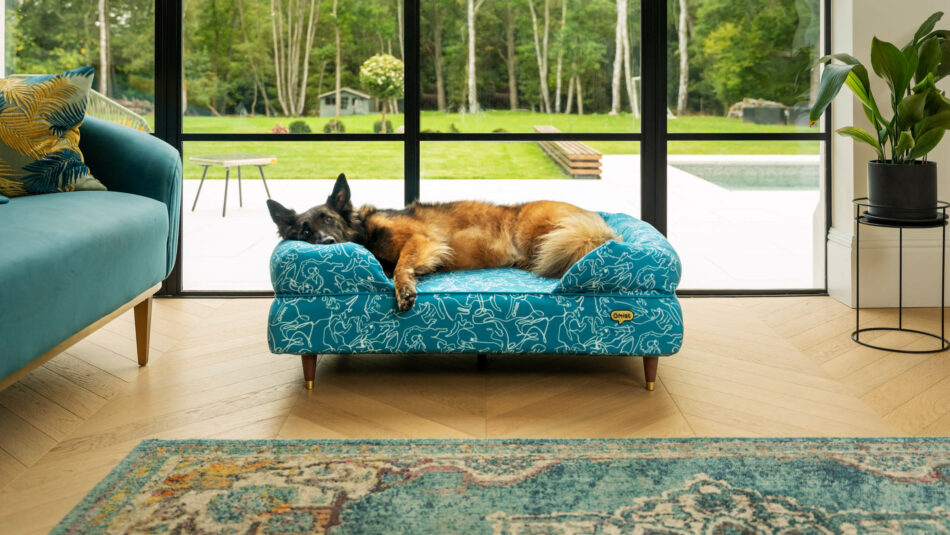

This entry was posted in Dogs
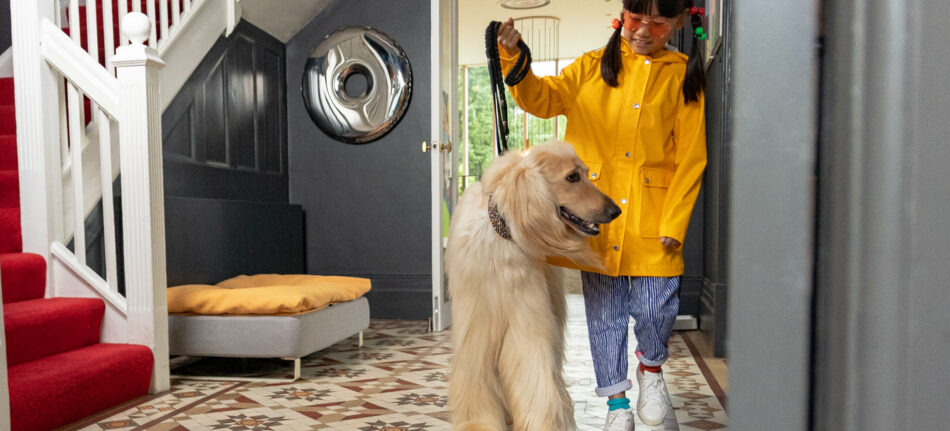
If there’s one thing we can all agree on, it’s that our furry friends bring boundless energy and infectious enthusiasm into our lives. And as responsible pet owners, we want to ensure our dogs live their best lives, filled with vitality and joy. But how do we determine the right amount of exercise for our canine companions? In this comprehensive blog, we’ll discuss everything from the importance of regular walks to the connection between exercise and sleep all to better understand how much you should be working out with fido.
Understanding your dog’s exercise needs
Dogs, like humans, require different levels of exercise depending on various factors such as age, breed, size, and health condition. Here’s a breakdown:
Puppyhood:
Just like kids, puppies need their daily dose of play and activity to channel their boundless energy positively, prevent boredom, and foster good behavior habits. Regular exercise is crucial for puppies as it promotes healthy growth and development, strengthens muscles, and improves cardiovascular health, setting a foundation for a long and happy life.
Aim for around 5 minutes of exercise per month of age, up to twice a day, for puppies. This helps prevent overexertion and joint stress while still promoting healthy growth and development. Puppies need a balance between activity and rest to thrive, so tune in to their cues and adjust exercise accordingly.
Adult:
Whether it’s a brisk walk, a game of fetch, or a romp at the dog park, keeping our canine friends active not only enhances their physical fitness but also strengthens the bond between pet and owner. Regular exercise is crucial for adult dogs to maintain optimal health and well-being, just like it is for us humans.
Adult dogs generally require about 30 minutes to 2 hours of exercise per day, depending on factors like breed, age, and health status. Regular exercise keeps them mentally stimulated, maintains a healthy weight, strengthens muscles, and promotes overall well-being. A well-balanced exercise routine will make your adult dog feel well for longer.
Senior:
Our furry seniors need their daily dose of exercise to keep their tails wagging and their joints moving smoothly. Regular exercise helps senior dogs maintain a healthy weight, boosts their mental sharpness, and keeps their spirits high, ensuring they can continue enjoying their golden years to the fullest.
Senior dogs typically benefit from around 30 minutes to 1 hour of moderate exercise per day, tailored to their individual needs and health status. This amount helps maintain joint flexibility, muscle strength, and mental stimulation, promoting overall well-being and a longer, happier life.
Size and breed:
Tailoring exercise routines to suit a dog’s size and breed is crucial for their overall well-being. For instance, energetic breeds like border collies require vigorous daily activities such as long walks or engaging in agility training to stimulate their minds and bodies effectively. Conversely, smaller breeds like chihuahuas may not need as much physical exertion but still benefit greatly from short, frequent walks to maintain a healthy weight and prevent boredom-induced behaviors like excessive barking or chewing.
But how often should I walk my dog? That’s where understanding your pup’s specific breed and size matters. Larger, high-energy breeds like labrador retrievers may require at least an hour of vigorous activity daily to keep them happy and healthy, while smaller breeds like pugs may thrive with shorter, gentler walks or indoor play sessions to prevent overexertion and joint issues.
Ideas for exercise routines
Mixing up your dog’s exercise routine keeps things exciting and helps target different muscle groups. So tailor the exercise routine to your dog’s preferences and abilities, ensuring a fun and engaging experience for both of you. Here are a few ideas to consider:
Walks or jogging: While walking your dog might seem like the obvious choice for exercise, making it a habitual routine is what matters. So make it fun – get a dog collar and leash that fits your dog’s personality, lace up your shoes and head out together to walk or jog around the block. You can thank your dog for giving you a reason to stay healthy too.
Explore new places: Ready to take your dog walks to the next level? Spice up your exercise routine by exploring new trails, beaches, or even dog-friendly hiking spots. Let your pup sniff and discover the great outdoors while you both soak in some fresh air and scenery. Just be sure to bring a comfy, easy-to-travel dog bed so they have somewhere to rest on the way home.
Swimming sessions: If your pup is a water lover, like an Irish Setter or otterhound, consider swimming sessions as a great way to exercise. Whether it’s a dip in the backyard pool or a visit to a dog-friendly beach, swimming provides a low-impact workout that’s easy on the joints and a whole lot of fun for everyone.
Agility classes: If you like adventure and think your dog does too, sign up for agility classes together. Not only does it provide physical exercise, but it also stimulates your dog’s mind as they navigate through obstacles like tunnels, jumps, and weave poles. Plus, it’s a fantastic way to bond and boost their confidence.
Fetch and beyond: Engage your dog’s natural instincts with interactive games like fetch, hide-and-seek, or tug-of-war. Grab some dog toys and create a play session in the comfort of your own home to get fido moving. These games not only keep them physically active but also mentally stimulated, satisfying their need for both exercise and mental enrichment.
Doggie playdates: Have you ever seen kids on a playground? They’re running around, engaging in fun and moving their bodies. Well, the same thing happens when dogs get together. Arrange playdates with other friendly dogs to let them burn off energy while socializing. Whether it’s at a local dog park or a friend’s backyard, watching them zoom around with their furry pals is guaranteed to bring smiles, and exercise, all around.
Impact of exercise on sleep
Regular exercise isn’t just about keeping your furry friend fit; it also plays a crucial role in ensuring they get a good night’s sleep. Just like us humans, dogs reap numerous benefits from staying active during the day. When your pup gets their daily dose of physical activity, whether it’s a brisk walk, a game of fetch, or an agility session, it helps to tire them out both mentally and physically. This exhaustion isn’t a bad thing—it’s the key to unlocking deep, restorative sleep.
You’ve probably noticed how your dog flops down contentedly after a day of play, snoozing soundly without a care in the world. That’s because exercise helps regulate their internal clock and promotes relaxation, paving the way for a peaceful slumber. Plus, a tired dog is less likely to engage in nighttime shenanigans like excessive barking or restless pacing. So, by making sure your furry companion gets enough exercise, you’re not only enhancing their physical health but also setting them up for sweet dreams and blissful nights of sleep.
Omlet and your dog
At Omlet, we understand the importance of keeping your pets happy and healthy. That’s why we offer a range of innovative pet products designed to enhance your dog’s well-being. From interactive dog toys to cozy, easy-to-clean dog beds, our products are crafted with your pet’s comfort and happiness in mind. We didn’t invent dog products – we invented designs to make dog products better so you and your dog can spend more time together being happy and healthy.
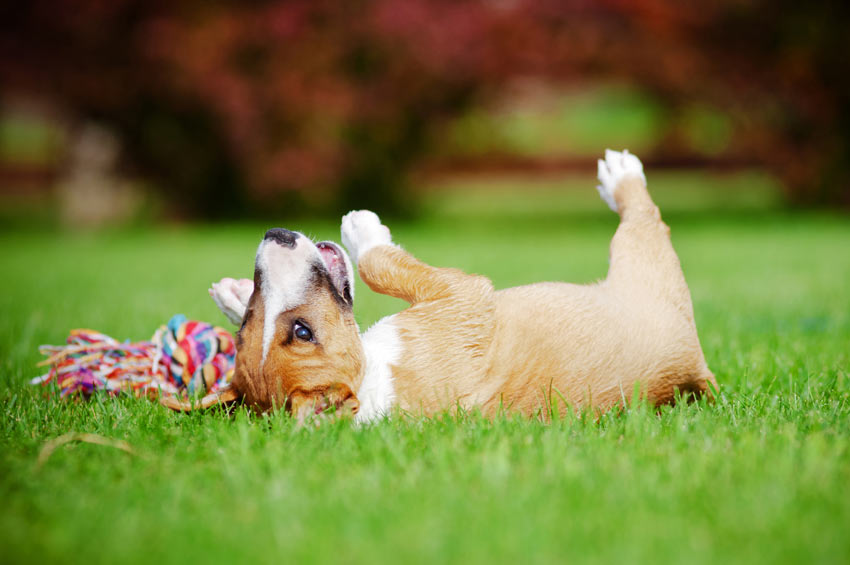
This entry was posted in Dogs
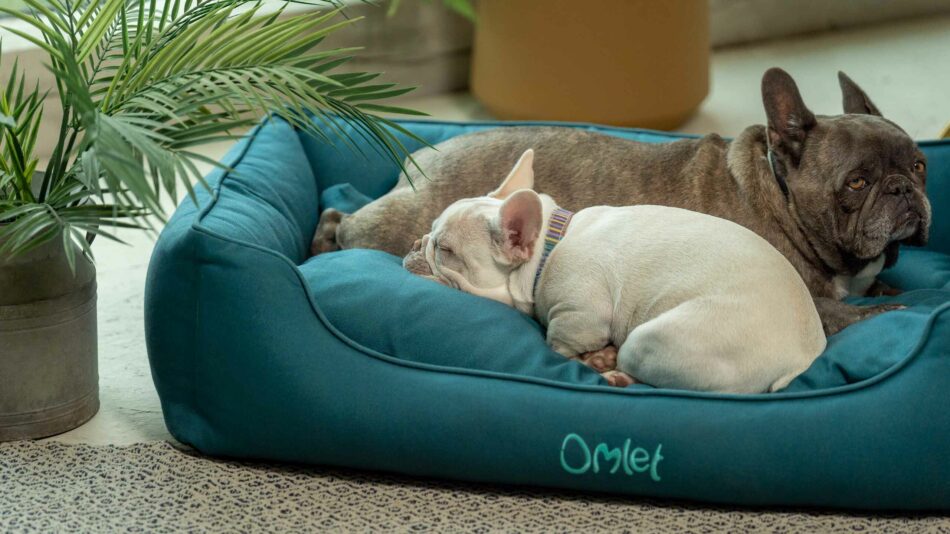
We’ve all heard about sleep schedules for babies and the importance of routine and adequate rest for their growth and development. But what about our furry companions? How much sleep should your dog be getting? As it turns out, just like humans, dogs require a significant amount of sleep to stay healthy and happy throughout their lives. Understanding their sleep needs can ensure we provide them with the rest they require to thrive.
Puppyhood to Senior sleep
Much like humans, the sleep needs of dogs evolve as they age. Puppies, with their boundless energy, may seem like they’re always on the go. However, puppies actually need (and usually get) more sleep than adult dogs. A typical sleep schedule for a young puppy can be anywhere from 18 to 20 hours a day. Because, just like babies, puppies need sleep in order for their bodies to grow.
But as your bundle of fur grows into adulthood, their sleep gradually decreases. Depending on dog breed and size, most adult age dogs will only require about 12 to 14 hours of sleep a day. Senior dogs, on the other hand, will start to log more sleep hours again, often clocking in around 14 to 16 hours per day. Understanding these sleep changes can help you tailor your dog’s specific environment to support their rest.
Why dogs need adequate sleep
Just like humans, dogs require plenty of quality shut-eye to maintain their health and happiness. Imagine your dog bounding through the park, chasing after balls, and eagerly greeting every passerby. Now, picture them doing all that on a measly few hours of sleep. It’s just not feasible. Here’s why our furry companions need their beauty rest:
- Physical recovery: Dogs need sleep to repair and rejuvenate their bodies after a day of activity. It’s during sleep that their muscles recover and grow, ensuring they stay fit and agile.
- Mental well-being: Dogs process a lot of information throughout the day, from learning new commands to deciphering the world around them. Adequate sleep is crucial for consolidating memories and maintaining cognitive function.
- Emotional stability: Have you ever noticed how cranky you feel after a sleepless night? Dogs are no different. Sufficient sleep helps regulate their emotions, keeping them calm and less prone to behavioral issues.
- Immune system support: Sleep is essential for a strong immune system. Dogs need adequate rest to fend off illnesses and stay healthy, just like humans.
So, the next time you catch your canine companion dozing off, rest assured they’re simply taking care of themselves.
The right dog bed makes a difference
Do you think you could get a good night’s sleep on just any mattress? Then your dog won’t either. Providing your dog with the right bed isn’t just about comfort; it’s about their overall relaxation and well-being. A comfortable dog bed is essential in helping your dog unwind, feel safe, and alleviate joint pain, especially for older or larger dogs.
Elevate their sleep: The right dog bed can truly transform your pup’s snooze game. With the Topology dog bed designed by Omlet, it’s not just a surface to crash on. This truly customizable and machine washable dog bed features a raised foot design that improves airflow, ensuring better air quality and comfort for your furry friend.
Surround them in comfort:: Imagine a bed that wraps your dog in complete coziness, like a warm hug. That’s the magic of the Bolster dog bed designed by Omlet. With its memory foam backing, it’s like giving your pup their own miniature couch, offering unparalleled support and relaxation.
Snuggle-worth nesting: Some dogs are all about that nest life. The Nest dog bed designed by Omlet takes plump sleep to a whole new level, providing the perfect cozy spot for pups who love to snuggle up tight. It’s like having a built-in cuddle buddy, minus the slobber.
Versatility meets comfort: When it comes to versatility and comfort, the Cushion dog bed designed by Omlet reigns supreme. Whether your pup wants to lounge in the living room, chill on the patio, or even accompany you on a road trip, this bed’s got them covered—literally. It’s as adaptable as it is comfy, making it a favorite for dogs on the go.
Ideal placement for dog beds
Where you place your dog’s bed can significantly impact their ability to relax and rest. Always opt for quiet, tranquil areas that are away from high-traffic areas and noise. Consider placing their bed in a spot where they can still feel connected to the family without being disturbed.
Additionally, keeping their bed clean is essential. Washable dog beds, like the Topology Dog Bed, make it easy to maintain a hygienic sleeping environment, promoting better sleep and overall health for your furry friend.
Better sleep = better health
Just like humans, better sleep translates to better health for dogs. A well-rested dog is more energetic, responsive, and engaged during walks and training sessions. And when your dog feels well rested and full of energy, you can’t help but reciprocate, further fostering a stronger connection and mutual understanding with each other. By prioritizing their sleep needs, you’re investing in their overall health and happiness.
Omlet and your dog
As pet owners, it’s our responsibility to ensure our furry companions receive the care and attention they need to thrive. Understanding their sleep requirements and providing them with the right environment, including a comfortable dog bed, plays a crucial role in their well-being. Omlet understands these needs and strives to innovate products like our designer dog beds and plush dog blankets that cater to every pet’s needs, ensuring they lead happy, healthy lives. So, next time you tuck your dog into bed, remember the importance of quality sleep for their vitality and longevity.


This entry was posted in Dogs
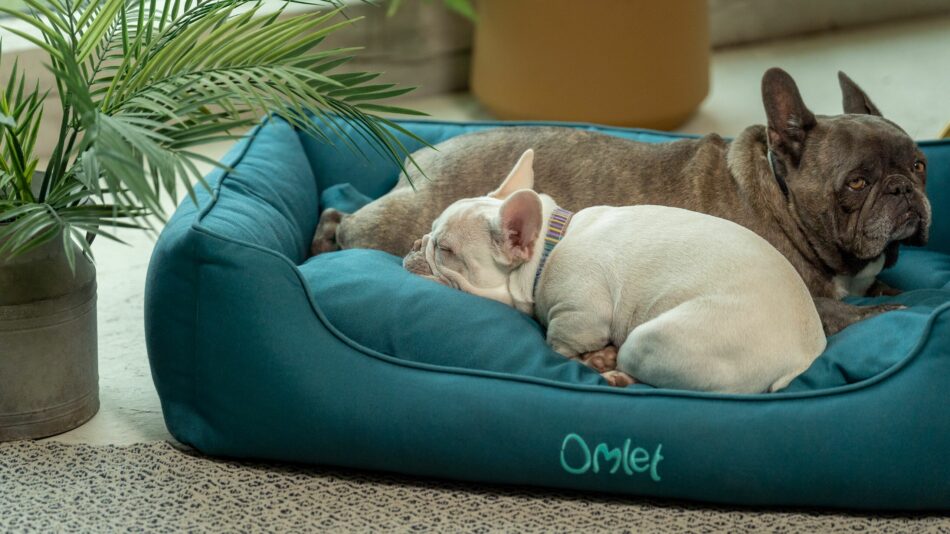
Have you ever watched your furry friend drift off into a deep slumber, legs twitching and softly whimpering, and wondered: do dogs dream? It’s a question that has intrigued pet owners for centuries, sparking curiosity about the inner workings of our canine companions’ minds. Let’s delve into the fascinating world of dog dreams and uncover the truths behind those mysterious nighttime adventures.
The science of dog dreams
Even though our dogs can’t awaken and tell us all about their dreams, scientists have long studied the sleep patterns of dogs to understand if they experience dreams similar to humans. Research indicates that dogs undergo similar sleep cycles to humans, including stages of deep sleep and REM (rapid eye movement) sleep, which is associated with dreaming.
During REM sleep, brain activity increases, resembling that of a waking state, suggesting that dogs in fact do experience dreams. But, our canine companions only experience REM sleep in 45 minute cycles on average. And depending on your dog’s breed and size, their dreams can last anywhere from 1 minute to 10 minutes.
While scientific evidence strongly suggests that dogs do dream, the specifics of their dream experiences remain elusive. Just like humans, dogs process their daily experiences and memories during sleep, leading to vivid dreamscapes that may involve familiar places, activities, or interactions. So the next time you see your furry friend twitching their legs in their sleep, they may just be dreaming about the game of catch you played with them earlier.
What do dogs dream about?
While dogs and humans share similarities in their dreaming experiences, there are also notable differences. Dogs’ dreams may be more heavily influenced by sensory stimuli and instinctual behaviors, reflecting their unique perspective on the world. Additionally, the duration and frequency of dreaming episodes vary among individual dogs, adding further complexity to the comparison.
Although we can’t peer into a dog’s subconscious, behavioral observations provide clues about the content of their dreams. Dogs often exhibit movements and vocalizations during sleep that mimic behaviors seen while awake, hinting that they may be reenacting past experiences or engaging in imaginary scenarios.
As cherished members of our families, it’s natural to wonder if our dogs dream about us. While there’s no definitive answer, studies suggest that dogs likely incorporate familiar faces and interactions into their dream narratives. So yes, it’s entirely possible that your dog dreams of bounding through fields with you or receiving belly rubs on lazy afternoons.
Dreamiest dog sleep solutions
When it comes to ensuring our furry friends get the dreamiest sleep possible, Omlet has you covered with our innovative dog bed solutions. We know sleep is important to dogs – like, up to 18 hours a day (or more) important. So we set out to ask the right questions to invent better ways to care for our beloved pets. Providing your dog with the perfect bed is key to their well-being and their dreams.
For the snugglers out there, the Nest dog bed is like a cozy cocoon, offering a warm and secure haven for those who love to curl up tight. Meanwhile, the Topology dog bed is ideal for leg splayers, providing ample space and support for dogs who sprawl out in all directions. And let’s not forget the Cushion dog bed, a versatile option perfect for on-the-go naps or as a comfy spot in any room of the house. With Omlet, you can rest assured that your furry friend will be dreaming in style and comfort, no matter their sleep habits.
Omlet and your dog
As you watch your beloved pup peacefully snooze, it’s fascinating to consider the vivid dreams they might be experiencing. Understanding this aspect of their lives is just one more way to deepen the bond between you and your furry friend. At Omlet, we’re passionate about enhancing the lives of pets and their owners alike. That’s why we create a range of products that cater to every aspect of your dog’s needs and desires, from luxurious dog beds for the coziest dreams to stylish designer dog collars for those daytime adventures. Because when it comes to your canine companion, only the best will do.
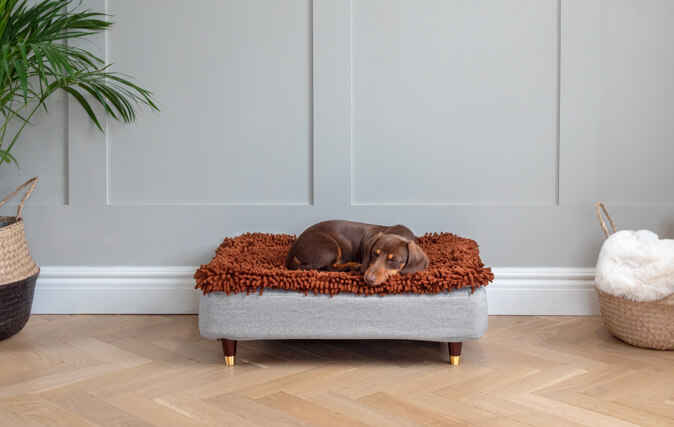

This entry was posted in Dogs
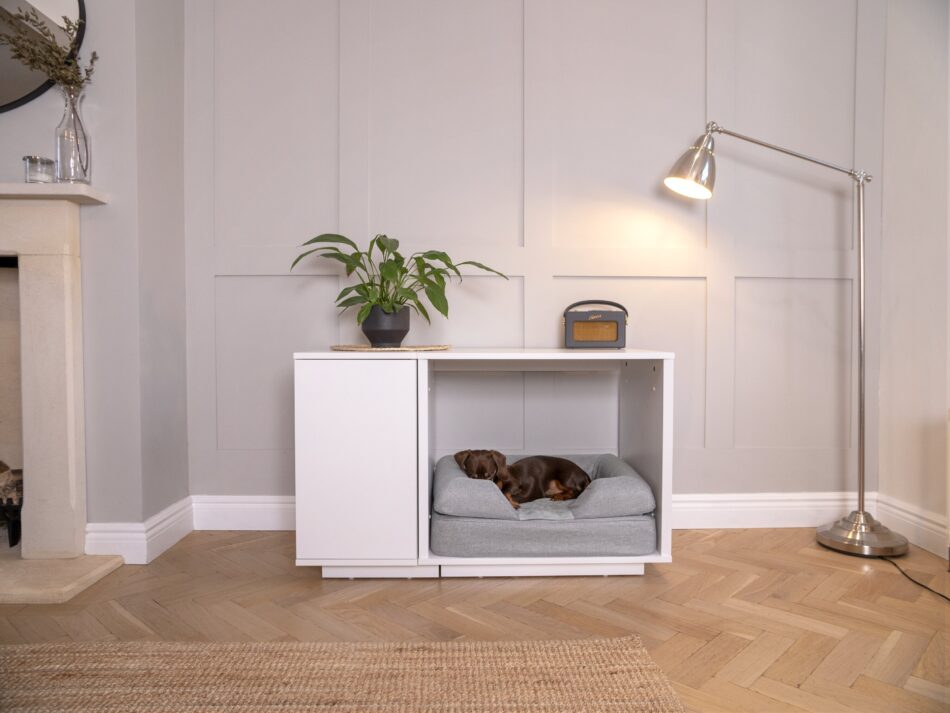
Finding the best dog crate is a crucial decision for pet owners, regardless of whether you have a small, big, high-stress, or elderly dog. It’s an essential tool for their safety, comfort, and overall well-being. With the vast array of options available, the quest for the ideal dog crate can be overwhelming. Thankfully, we’re here to help you navigate this very important decision with various options of Omlet dog crates that are suitable for all pups in all situations.
How to choose the best dog crate for your furry friend
Choosing the best dog crate for your beloved furry friend is like selecting the perfect home – it should be cozy, safe, and tailored to their unique personality. There are three main things to consider when choosing the perfect crate for dog:
First, consider the size; your dog crate should be spacious enough for your dog to stand, turn around, and stretch comfortably, regardless of their size. And remember to also account for your dog’s growth if they’re still just a puppy – as your dog grows, so, too, should their crate.
Next, think about storage. Where are you going to put your dog’s crate? Will it stay in your bedroom? Or will it be front and center in your living room? Whether you’re using the dog crate just for training purposes, or for a safety spot for them to relax, you will need one that is strong and durable. If you plan on using it as a doggie den for your furry friend, you may want to consider a dog crate that is built more like furniture and can complement your decor.
Lastly, you need to think about how you are using the dog crate. For many pet owners, a dog crate is only used for safety reasons, i.e. traveling in the car to the vet or on vacation. In this case, a dog crate that is easy to collapse and fold is ideal and will make both you and your dog’s lives easier! In addition, an easy-to-transport dog crate also means no hassle, and you’ll be able to move it around your home should you decide to change its location.
Best dog crates for large dogs
Big dogs need big things. And that includes dog crates. So if your furry friend is large like a German shepherd, Labrador, or Bulldog, you’re going to need a dog crate that will fit their size and stature. Our top choice is the Omlet large dog crates as they are designed with larger breed dogs in mind, providing ample space for them to stretch out comfortably and move around in. Its double doors not only allow for easy access, but flexibility of placement as well.
Best dog crates for small dogs
When it comes to small dog crates, Omlet has a range of design options engineered to cater to both the comfort of your smaller dog’s needs and the design of your home. The Fido Studio is a standout choice for petite breeds like the chihuahua, dachshund, or papillion as it offers a cozy den-like enclosure that also doubles as a piece of furniture. With its modern design, your pint-size pup will feel secure and safe in a comfortable spot that blends seamlessly into your home. Store your small dog’s favorite accessories in the optional wardrobe and create a room all their own.
Best dog crates for puppies
When it comes to puppies, dog crates are an essential part of parenting. Not only are dog crates crucial for their safety and puppy training, but for their comfort as well. The Omlet Fido Classic crate is an excellent choice for several reasons. Firstly, it provides a secure space where your puppy can’t get into mischief or danger. Which, in turn, also helps reduce the risk of destructive behavior!
Second, a dog crate for your puppy aids in-house training by leveraging a dog’s natural instinct to not use their sleeping area as a potty. Consider it a “bladder controller” that helps prevent indoor accidents.
To use a dog crate effectively for your puppy, ensure it’s appropriately sized, allowing them to move around in it freely and comfortably. Introduce positive associations, such as dog treats and dog toys, to make the crate a welcoming space. Then, gradually increase crate time so they become familiar with and used to using it as a spot for security. After a while, you can add a comfy puppy bed inside the crate to make this their designated spot.
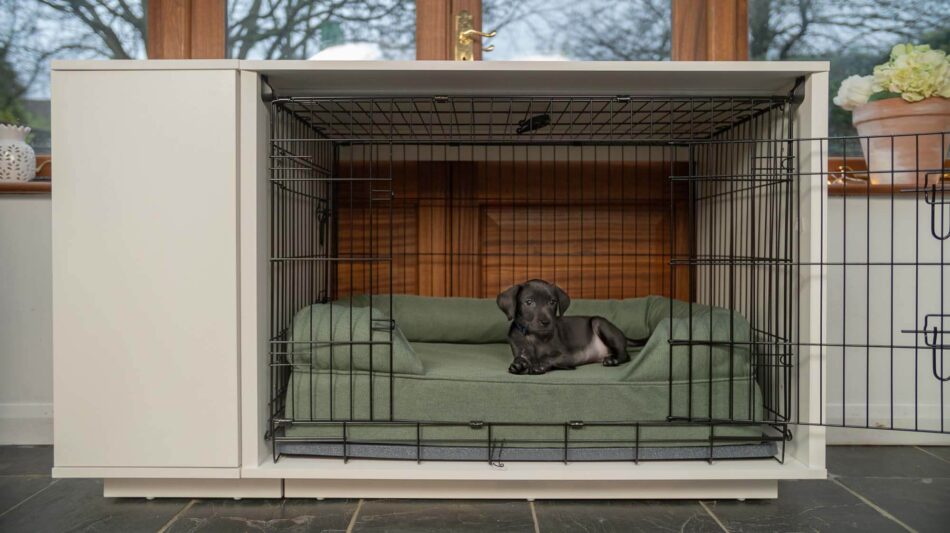
Best dog crate for senior dogs
You may be asking, “why would my senior dog who has lived their whole life without a dog crate suddenly need one?” Great question – we’re glad you asked. As dogs age, their needs change, and a dog crate can become a valuable addition to their life. Some senior dogs start to experience mobility issues or incontinence in their later years, and a dog crate becomes a safe and manageable place where they can rest and recover.
But can you teach an old dog new tricks? At Omlet, we know you can. Training a senior dog to use a dog crate is no different than training a puppy – it takes consistency, patience, and time. When it comes to reducing the stress and anxiety often associated with senior dogs, look no further than the Omlet Fido Nook. Curated with luxury and comfort in mind, this modern dog crate has been meticulously designed to give your dog a sense of comfort and priority in your home.
Best dog crates for travel
Embarking on a pet-friendly vacation should be easy. That was our thought process when we designed the Omlet dog crates to be versatile for travel with your favorite furry friend. Whether you’re road-tripping with your dog in the car or jet-setting across the country, our thoughtful design features help to give you and your dog a hassle-free travel experience. The tool-free assembly of the dog crate makes setup a cinch and your dog will love the cozy interior that keeps them safe during transit. Vacationing with your four-legged family member has never been so convenient.
Best dog crates to calm anxious dogs
Finding the perfect dog crate to soothe your furry friend’s anxiety is like discovering a cozy hideaway for their heart. The Omlet dog crates are not just enclosures, they’re ergonomically designed havens of hushed tranquility that transform anxiety into calm. Many dogs will whine or bark as a show of their unease but using a dog crate as a calming tool will help give them a safe place where they can feel less overwhelmed.
Best dog crate furniture
At Omlet, we believe dog crates should provide a space of comfort and peace for your dog while simultaneously not distracting from your decor. We asked ourselves, why can’t a dog crate be both functional and modern? And then we made it. Meet the Fido Nook Dog House – where dog crates are elevated to luxury that your dog deserves. Crafted with precision and style, we transformed the mundane dog crate into a statement piece, making your home a sanctuary of style and warmth for both you and your dog.
With the option to add a removable classic crate or just place your dog’s bed directly inside, the Fido Nook is truly the only dog house you’ll ever buy. The integrated closet acts as a storage unit for all of your dog’s accessories and helps to keep your house clean and tidy. This dog house serves as more than just a retreat, it’s a conversation piece in your home that is a testament to your love for your furry friend.
Create the ultimate den for your favorite canine
Now that you’ve settled on the perfect dog crate, it’s time to make it comfortable for them to settle into. Start by adding a cozy dog bed where they can rest and relax. Using a dog bed in your dog’s crate will help train them to know that this is a safe place to be and feel calm. Next, top off their coziness with comforting dog blankets that keep them warm and snuggled. It won’t take long for your favorite canine to learn that their dog crate is the ultimate den where they can feel secure, comfortable, and at peace.
Omlet and your dog
At Omlet, we go beyond the ordinary to invent the extraordinary, creating remarkable designs that last a lifetime. Whether it’s our dog crates, washable dog beds, raised dog beds, or designer dog leashes, we have the products your dog needs and deserves. Our mission is simple: make pet products better so you can spend less time worrying about them and more time with the furry friend you love.
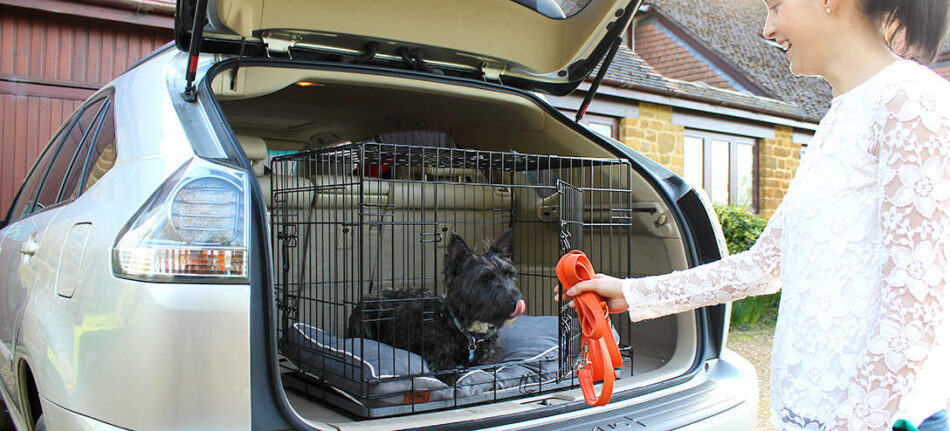

This entry was posted in Dogs

Canine behaviorist, Nikki Mather, explains our dogs’ adolescent phase and provides useful training advice on how to work through this stage successfully. Nikki, founder of Positive Steps Dog Training, is a qualified, force-free dog trainer (IMDT) and behaviorist (BCCS), predominantly working on cases including dog reactivity, separation anxiety and fear/anxiety-related behaviurs.
Most new puppy guardians prepare well for bringing home a new puppy, from toilet training to mouthing to sleeping through the night. And, just when you feel like you’ve mastered this stage of your puppy’s life, they turn into a teenager!
The teenage phase is a testing period of your puppy’s life, bringing new challenges and frustrations to you as a dog guardian. During this time, your dog may seem like they are purposely ‘ignoring’ your requests, they may become a little more anxious than before, or they may completely fly off the handle – but let’s take a look at what is really going on for our pups during this stage, as well as training tips to help you navigate this challenging time.
What is adolescence in dogs?
The transition from puppyhood into an adolescent “teenage” dog can happen anytime from around 6 months, lasting until your dog reaches anywhere between 18 – 24 months. During adolescence, dramatic hormonal changes take place within your dog’s body, resulting in a rewiring of their brain.
During your dog’s teenage months, you may notice an increase in their confidence, becoming increasingly motivated to explore and interact within the external environment. Alternatively, your once seemingly confident pup may begin to exhibit more anxious, fearful behavior. Regardless of the change, it’s important to remember that although older, your pup still lacks the experience and skill set to appropriately navigate our world and, therefore, is sometimes unable to rationally manage their emotions and reactions.
Behavioral changes you may notice
1. Increased anxiety (and therefore reactivity)
Most new puppy guardians are well aware of the importance of appropriately socialising your pup between 8-16 weeks. However, most aren’t aware that our dogs enter into a second fear period generally between 6-14 months.
During this stage, you may notice your once confident pup has become a little more anxious and fearful, which could result in an increase in reactive behavior towards external triggers they once may have been comfortable around, such as people and other dogs.
In order to work through your dog’s second fear period successfully, it is important to continue their socialisation training to ensure they are continually exposed to triggers at their pace. This will help continue to build positive associations that will create the foundations of a well-adjusted, confident adult dog.
2. Regression in training
We’ve all been there – we bring home a little puppy and immediately begin working on their loose lead skills and recall training. All goes seemingly well…our pups don’t want to leave our side so their lead work is perfect, their recall is second to none and they hang onto every word we say!
Then, the teenage stage hits, and it feels as though everything goes out of the window and our young dogs know nothing!
You’re not alone in this – ‘regression in training’ is completely normal. During the adolescent months, our dogs’ hormone levels change, and they can become much more confident in themselves and their environment. You may notice they listen to you less, they run over to distractions outdoors and they don’t come back when you ask – super frustrating! During this stage, our dogs are often conflicted when asked to do something, driven predominantly by their uncontrolled impulses.
When you begin to notice this regression, don’t panic! You just have to go back to basics in your training – in other words, you need to make it easier for your dog! This might mean you go back to working with a long training lead when teaching recall, or you may give your dog a little more distance from distractions to help them focus on you more. Take the time to work through your dog’s regression, training at a pace they can handle, and you’ll come out the other side with an adult dog that is an absolute dream to have!
3. Ignorance!
During your dog’s adolescent phase, you may become increasingly frustrated by how much they are choosing to ignore anything you ask of them – you may even call this stubbornness! Whilst this may seem like your dog is actively choosing to defy you, it is more effective to try and understand where this ‘ignorance’ has come from.
When they were pups, YOU may have been the most exciting, rewarding thing for them. Now that they’re a little older, their motivators and preferences will change, and you’ll need to up your game in order to keep their attention in a stimulating world.
To do this, you can try using high-value treats to reinforce behaviors you like, such as fresh meats, doggy pate or cheese (within moderation). You can also use chase toys, tug toys or balls to better engage your dog and reward behaviors you like. The more you reward a behavior, the more likely that behavior will be repeated!
4. Increased energy levels
As a pup, your dog will have needed around 16-18 hours of sleep per day. Now that they are a teenager, their sleep requirements will reduce, so they may become more active around the home for longer periods of time (more time to get up to mischief!)
Now more than ever, it is important to ensure you are meeting all of your dog’s needs, including physically, mentally, socially and breed-specific. Consider the quality of your dog’s walks, how often do they engage their brain in stimulating activities such as sniffing and problem-solving, do they have ample opportunities to engage in play with you and other dogs (when suitable), and are their breed-specific needs to chase/dig/search etc. being met?
If your dog is restless and exhibiting unwanted behaviors, there is probably an unmet need that needs to be addressed!
5. Nuisance behaviors
The adolescent developmental stage is when most young dogs begin to show troublesome behaviors, such as excessive barking, jumping, lunging, destruction or biting/nipping. Such behaviors are typically a result of your dog working through some pretty big emotions, frustration sometimes making top of the list.
If you notice your dog showing unwanted behavior, ask yourself WHY? There’s always a function behind our dog’s behavior – is there something they want, is there a need not being met, are they bored, tired, frustrated etc. Once you understand why the behavior is occurring, you’re better equipped to implement efficient training solutions!
Quick tips to help satisfy your adolescent dog:
- Let them sniff on their walks as this will tire them out mentally.
- Provide indoor mental stimulation such as enrichment boxes, snuffle mats and treats rolled into a towel!
- Balance high-energy activities with brain work-outs e.g. 5 minutes ball throwing followed by 10 minutes sniffing to help reduce adrenaline.
- Ensure you’re engaging with them through games, training or just cuddles – our dogs are social creatures!
- Teach them how to settle using a settle mat and ensure they have a quiet, undisturbed space to relax around the home.
Remember, your dog’s adolescent period will not last forever. Be patient and guide them into making more appropriate choices to help them co-exist peacefully with you. ‘Bad days’ are inevitable, but your hard work and consistency will pay off, and the relationship you’ll build with your dog along the way will be the most rewarding of all.
If you’re struggling and would like some professional help, please do get in touch with us at Positive Steps Dog Training.
This entry was posted in Dogs
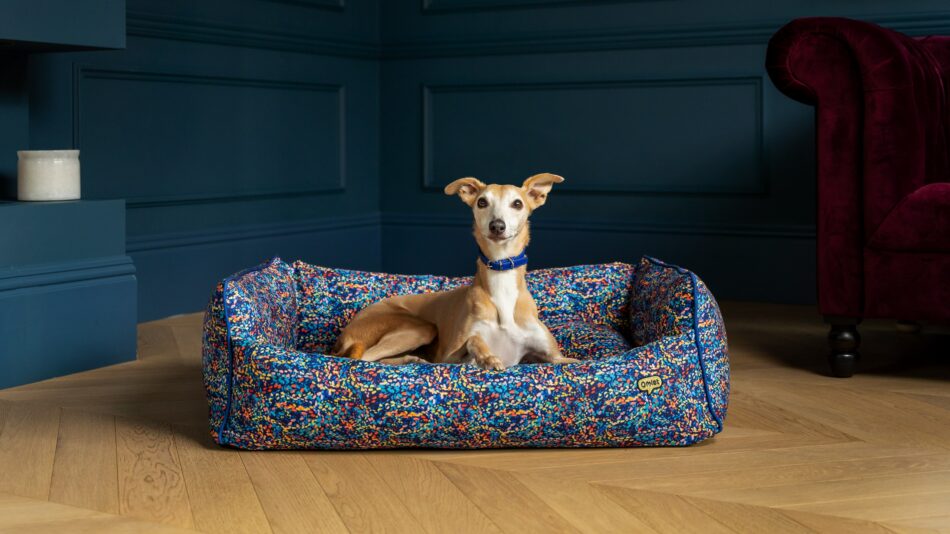
Is there anything more irresistible than those puppy-dog eyes? However mischievous, we love and forgive our dogs unconditionally, even if that means the occasional missing pair of socks. Pet parenthood is far from perfect, but it’s our pups’ mischievous little ways as well as their sweet ones that brighten up our days and make it all worth it. But, when does their behavior become a bigger problem and what’s the science behind their naughty nature?
Loveable rogues
It’s fine, they’re still so little, or perhaps your backyard needed a new hole dug anyway…Whatever your excuse for your dog, we’ve all been there. But sometimes there are genuine explanations as to why Fido is acting up. Here are some of the most common naughty dog behaviors and why they happen.
Just one more treat, please
Dogs beg for a number of reasons. Whether it’s to jump up on the couch, for a piece of your food or just for a bit more attention, they definitely know how to make it known when they want something. It’s easy to be fooled by the pitiful whines and pawing of a pooch but this tactic can be a nuisance when it becomes a habit.
If this attention-seeking behavior has spiraled out of control, it’s important not to reinforce it by giving in to what they want. Instead, try redirecting them to something else to keep them occupied such as a dog toy that they can be alone with, or creating physical barriers such as a baby gate if your dog is begging at the dinner table.
Dogs that dig
The backyard should be somewhere for all the family to enjoy but can quickly become the opposite should Fido get their paws dug in. Digging isn’t uncommon, especially for certain dog breeds such as the Airedale terrier, Border terrier and Australian shepherd. While it might be in their DNA, you can deter the digger from your yard and instead, divert them to a more controlled indoor environment with this boredom-busting digging game from our previous blog.
For some, it’s in their genetics, but other dogs dig to relieve stress, to escape or to store their food. Ensure you’re providing them with both physical and mental stimulation and rule out any medical conditions via your veterinarian.
All paws on the floor
Being greeted by a jumping puppy is undeniably cute, but as our pint-sized pups grow into much heavier adult dogs, this behavior can not only take us by surprise but can also be dangerous. For dogs, a face-to-face greeting with their favorite people is simply a way to get attention as well as to show their affection, so should never be punished.
However, with a bit of persistence, your pup can learn that having all paws on the floor is a much better way to get what they want. Any time they decide to jump up at you or anyone else, turn your back and ignore them. Once they’ve sat nicely, reward them with plenty of dog treats and fuss.
Shoes for chews
From shoes to table legs and even bed frames, a chewing dog is a persistent one and this habit can soon see your entire house gnawed. Before dealing with this issue, let’s first recognize what normal dog chewing behavior is.
Puppies explore the world through their mouths, which is why they’re notorious chewers. This is perfectly normal, although it’s essential that you provide them with plenty of enrichment, including chew toys so that they don’t nibble what you don’t want them to.
Older dogs, however, may chew due to canine separation anxiety, boredom or an unbalanced diet. Just as with puppies, offer them plenty of toys and dog-appropriate chew bones (not rawhide) while addressing any medical concerns with your veterinarian such as them becoming stressed when left alone.
Fido the thief
Being chased around with something they’ve stolen is a pretty fun game for dogs. And what’s even more fun for Fido, is the chase ending in a game of tug of war with said stolen item. Dogs steal for attention and when we engage with them, it’s simply reiterating that they can take whatever they please and it will result in a play session. Items that smell like us such as socks are firm favorites but disaster can strike when something more valuable is taken.
Teaching your dog the “drop it” and “leave it” commands is a good place to start. With consistency, they’ll soon learn that not taking what you don’t want them to, will earn them an even better reward such as their favorite treat or game.
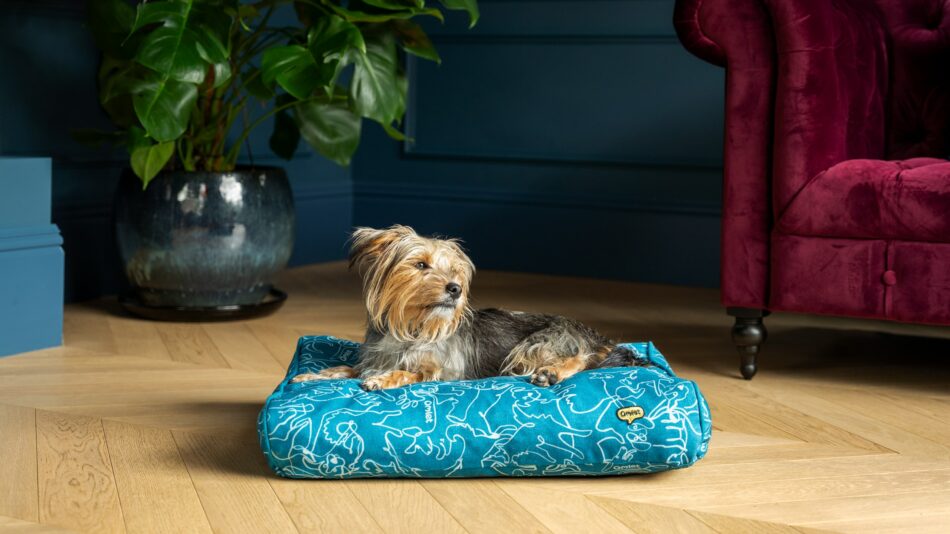
Naughty by nature or nurture?
It’s no secret that some dogs are more naughty than others. Age, for one, is a huge contributing factor, with puppies being the most mischievous of them all. But, it isn’t always a lack of training that leads to naughtiness.
Dog breeds such as the energetic Jack Russell terrier, Siberian husky, Border collie and beagle are also ranked highly on the naughty scale either for their playful nature, apparent inability to resist food or becoming most destructive when not provided with enough stimulation.
The best beds for naughty pups
Muddy carpets. Trash trained from basement to bathroom. But look at that face. Those eyes. We wouldn’t have it any other way. How, we wondered, to tell the story of the mad love and mortification that comes with being a dog parent? With the Mischief Collection we celebrate the ‘shake your head in despair’ delight that only dog lovers understand.
Our in-house textile designer Victoria took it to the drawing board, and so started our latest, limited edition Mischief dog bed collection.
Three on-trend yet timeless prints, inspired by the ‘oh crikey, what now’ moments of sharing your space with a four legged bundle of relentless love, loyalty and face palming frustration.
Evocative of wet pawed, tail wagging wanderers, Patterpaws brings our dogs’ happy-go-lucky optimism to life with an upbeat energy that’s bang on trend.
The frenetic, graphic print in earthy tones of Zoomies traces the invisible tracks they follow as they race and swerve. Seasonal shades of ochre and chartreuse perfectly balance zippy, zany zig zags.
This minimalist, single line sketch design has a Scandi vibe. On closer inspection, Doodle Dog tells a tale of dogs of all types, their movement and motion vividly captured with deceptive simplicity.
Mischievous or more?
A playful pup who has you wrapped around their paw is often nothing to be worried about. But when mischievousness crosses the line, it can become an issue. For example, resource guarding may occur if a dog has stolen an item they deem valuable. Signs include your dog growling, baring their teeth or lunging when approached. Or perhaps what was once a reliable recall has seemingly disappeared. Should you be concerned about your dog’s behavior, it’s important to seek training from an accredited, force-free professional.
Omlet and your dog
Trouble-making hound or angelic canine, Omlet has the best products to support all dogs and their owners. From easy-to-clean dog beds, to dog toys and dog crates, find out how caring for your pet in a better way is possible through the wondrous world of Omlet.
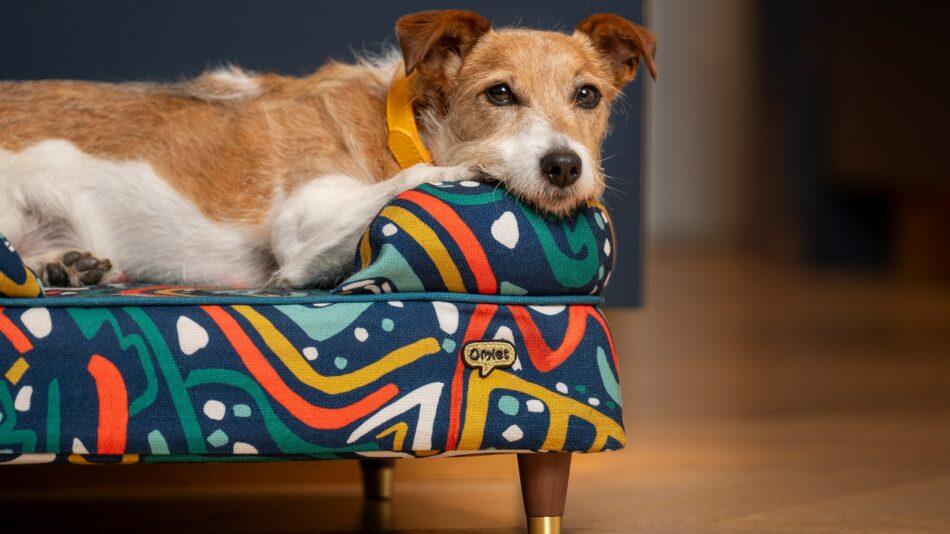

This entry was posted in Dogs
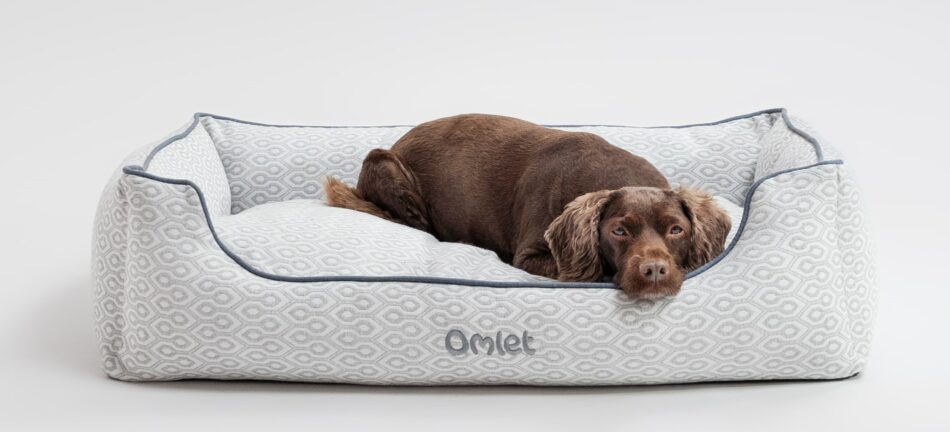
It’s no secret that dogs are smart, but with such intelligence comes an innate need to be stimulated. While your post-work weekday walks might occasionally seem a chore, our canine companions thrive when tested both physically and mentally, so finding activities to help bust dog boredom will prevent them from causing mischief. Here are some ideas to try and keep Fido out of trouble.
Bored dogs – spotting the signs
A bored dog is actually quite simple to spot. If you notice any of the following, then your pup could be trying to tell you they’re in need of more fun.
Destructive behavior
Chewed-up shoes, gnawed chair legs and loose stuffing dotted around your home… sound familiar? Destructive dog behavior is frustrating, but behind it all, the cause is often boredom. But with no other outlet for their emotions, dogs often turn to destroying your and their own property.
This being said, some behaviors, such as chewing, are also associated with canine anxiety, as well as puppyhood, which you can read about in our previous How to redirect your puppy’s chewing blog.
Whining and woofing
Notice your dog whining and woofing a lot more than usual? It’s not unusual, especially for certain dog breeds, to make a lot more noise than others, but if you see that it’s becoming more relentless with no apparent reason, this could be another sign of boredom after you’ve ruled out any illness or injury.
Getting dizzy?
Watching Fido chase their tail might initially be entertaining for us to watch, but if your dog is doing so obsessively, this could indicate an underlying problem. In younger dogs, this behavior is most likely nothing more than a playful pup discovering what that thing attached to them is! But, if you suspect your dog’s tail-chasing is becoming a habit, contact your veterinarian. Should there be nothing of concern, you could simply have a bored canine who needs a little more attention.
Persistent pacing
Restless dog behavior can include pacing. If your dog is going up and down your home in a frantic manner on a regular basis, then boredom could be to blame.
Off I go!
Got a Houdini hound on your hands? A dog that is frequently attempting to, or successfully, running away from home could be off to find entertainment elsewhere. Losing sight of your dog is a terrifying experience for any owner and when you’re providing such a loving home, it can be puzzling as to why they’d want to leave. Fortunately, most will find their way back and it’s important never to direct your frustration at them. Rather, see this as an opportunity to provide some more stimulation.
Commanding attention
Other than whining and barking, dogs can seek attention in any other way they know that will get their owners to make a fuss (even if it means when they’re getting into trouble!). This can include pawing and nudging, jumping up at you, dropping a toy on your lap and even stealing your favorite pair of shoes. A bored dog is a needy dog, so making sure you provide them with enough stimulation is key to putting this behavior to bed.
Boredom-busting solutions
Now you know what to look out for, here’s how your furry friend can be on their way to living a more fulfilled and happier life.
Get digging
Dogs love to dig, especially terriers such as the Border terrier, Jack Russell and fox terrier. But, finding them digging up the backyard isn’t so fun for us. Instead, encourage their digging instincts by creating a digging box they can use inside the home. All you need is a cardboard box, some scrunched up paper and a few of their favorite treats to bury inside. Or, you can even use a dog ball pit, hiding treats at the bottom.
Fido fit for purpose
Working dog breeds were originally bred to take on tasks such as guarding, herding and retrieving. Huskies, for example, were bred as sled dogs, while the Bernese Mountain dog was bred as a working farm dog to drive cattle and guard the farm from predators.
Today, many breeds are kept as loving family pets, so it’s inevitably not possible for every dog to fulfill needs they were originally bred to meet. Enrolling them in an activity that resembles their intended “job” can help keep boredom at bay. Finding toys, hide and seek, rounding up toys and throwing their ball in the water to fetch are just a few fun activities you can incorporate into their routine, depending on your dog’s breed.
Back to school
They might have already graduated from puppy training but there are plenty of groups available for adult dogs. This could be further sessions to brush up on their tricks or even agility. If you’re not sure that a class is right for your dog, you can also set up a dog obstacle course of your own at home.
Doggy brain training
With their intelligence akin to that of a child between 2 and 2.5 years old, dogs can really benefit from brain training as part of their boredom-busting routine. Brain training toys, which encourage them to locate their treats such as snuffle mats or Kongs are readily available or can be made at home.
You can try using a muffin tray filled with tennis balls and treats hidden underneath. Or, why not use a few empty yogurt pots or cups for them to work out which one the snack is under?
Pup playdates
Puppy play dates can be a great way for your dog to exercise. Perhaps you have a friend with a similar-sized dog that gets along with yours, or you can even join local groups of like-minded pet parents. But before you go ahead and unleash your dog, be sure to read our advice on how to make your dog’s play date a success.
Rethink your route
The same scenic stroll might be enjoyable for you but it’s important not to forget that a walk is for everyone involved – Fido included. Exploring a new walking route will give your dog new territory to explore with their nose and also the opportunity to try out training in another environment.
Alternatively, you can even try changing up the pace of your walking or letting your dog lead you. While letting your pup take the lead isn’t a habit you want to fall into, especially for leash pullers, occasionally allowing them to choose where they want to go can be a good way to switch up walks.
Omlet and your dog
And after all that exercise, what better for your pooch to relax than on an ultra cozy Bolster dog bed? A tired dog is a happy dog after all. Continue to discover the wondrous world of Omlet with our range of other dog products such as our dog crates that double as furniture, cozy dog blankets and luxury dog collars and leashes.
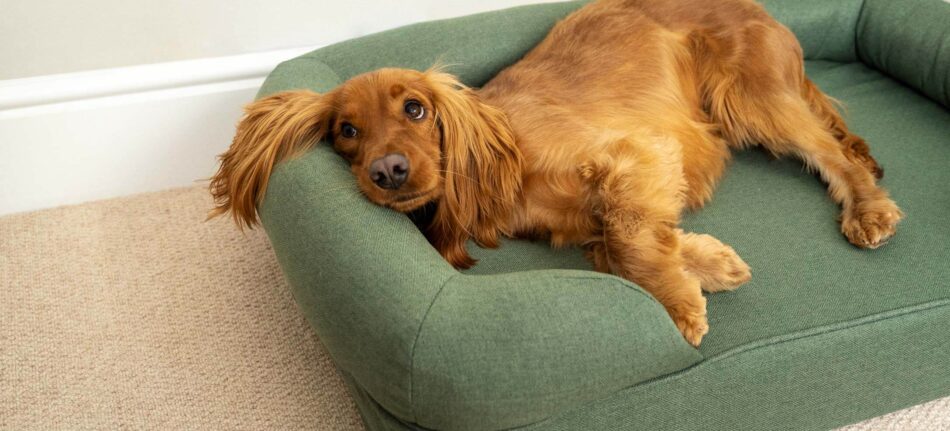

This entry was posted in Dogs

It all started with a dog walk, which inspired our first-ever limited edition signature prints. In this video, hear from our in-house textiles designer, Victoria, the ideator behind our designer dog bed prints and learn more about our steps towards a more sustainable dog bed.
Our latest collection, Gardenia, draws inspiration from our canine companions’ favorite places to wander, sniff and play. Available to
shop now.

This entry was posted in Dogs
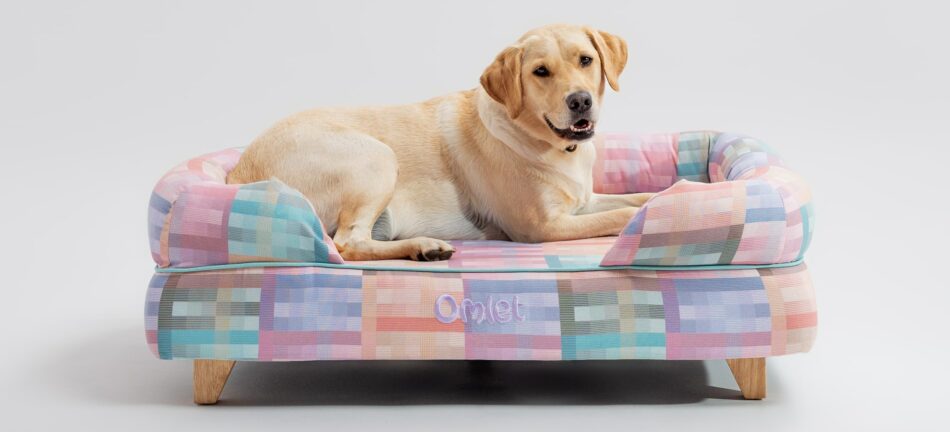
Whether it’s a post-walkies siesta or a full night’s recharge to power up for the next day’s adventure, dogs love to sleep. And with so many hours spent snoozing, where Fido decides to get their shuteye is crucial to getting in those all-important ZZZs. Whilst your dog might enjoy a cuddle on the couch or sneak into your bed as nighttime arrives, having a bed of their very own means a space that supports their specific needs. But with no two dogs quite the same, how do you find the best dog bed for your dog? At Omlet, we’ve made things easy and taken out the guesswork. Here’s our guide to finding your pup’s perfect sleep solution.
From puppy to prime
The standard dog bed only lasts between 6-12 months. We knew we had to do better, which is why we designed a dog mattress to last a lifetime with the Topology dog bed. But, we also understand that a dog’s needs change as they age, which led us to create a range of toppers to support every life stage of your four-legged friend. The Topology toppers can simply be zipped off from the Topology mattress, placed in the washing machine, and then zipped back on for that oh-so-fresh sheets feeling. Or, for when your dog reaches a new life stage, zip on a brand new topper to meet their adjusted needs, all while the memory foam support of the Topology mattress remains the same.
For playful pups
Recently got a puppy? We recommend the Topology dog bed with the Quilted topper, also known as the Topology puppy bed. The durable material of the Quilted topper is great for those inevitable accidents and razor-sharp pirana puppy teeth. Not convinced? We’ll even replace your topper for free with the Omlet 180 Day Puppy Guarantee scheme in the unlikely event that your pup manages to chew through their topper to the extent it can no longer be zipped onto their bed within 6 months of your purchase*.
Super for seniors
For senior canines, opt for the Topology dog bed with the Sheepskin topper. As dogs age, they struggle to regulate their temperature, meaning they need extra support to stay warm. The faux sheepskin fabric not only provides an extra layer of comfort to keep them cozy, but combined with the memory foam mattress of the Topology bed to support aging joints, creates a recipe for a dog bed of dreams.
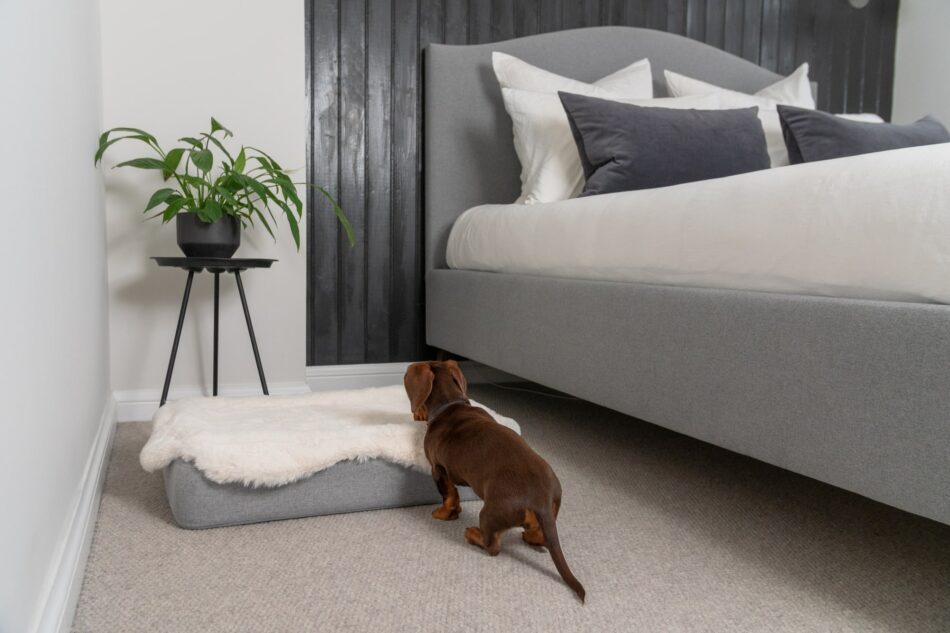
Best for your breed
It’s not just age that affects choosing the right dog bed. When it comes to beds, one size definitely doesn’t fit all and your dog’s breed can also play a part in finding the right sleeping solution for them.
Separation support
All dogs can struggle with canine separation anxiety, but some breeds such as the border collie, toy poodle and bichon frise are more prone to struggling when separated from their owners. Alongside seeking professional help from a behaviorist, having the right dog bed can help, though. The Bolster dog bed was expertly engineered to support the needs of anxious pups, with raised, wrap-around sides creating a pillow for your dog to rest their head and feel cocooned in for when they’re feeling on edge.
Mucky pups
It’s no secret that some dog breeds create a little more mess than others. Whether it’s the flying fur of a golden retriever, a slobbery trail from a bloodhound or muddy paws dotted around the home, our dogs have their own special ways of showing us their love. But, these tokens of love, can come at a cost. With a build-up of dirt, debris and hair, dog bed odors can soon spread to the rest of the home.
Fortunately, the Bolster dog bed has been designed with easy cleaning and home hygiene in mind. The covers can be removed in seconds and put in the washing machine on a gentle cycle. And when the covers are back on, your dog’s bed will feel and smell brand new. Plus, with the option to customize the dog bed with a range of designer feet, the Bolster can be elevated for easy cleaning and 360° airflow.
Suits you
Something else to consider when finding a dog bed is your lifestyle. But finding the perfect fit for you and Fido without compromising on their comfort can be a challenge. We asked ourselves, can we design dog beds that meet their needs and ours? Our answer: Yep, for sure. Whether you’re an avid adventurer who loves globetrotting with your canine companion at your side or a homebody interior expert who wants to match their dog bed to their furnishings, we have a dog bed for you.
Adventure ahoy
The Cushion dog bed is the go-anywhere dog bed. The lightweight material means taking your pup’s bed on your travels is a breeze. Keep it in the car for your next adventure, and bring it out when you’re ready to bed down at your destination. And filled with the just right amount of plump stuffing, the Cushion dog bed ensures your four-legged friend stays comfortable wherever they are.
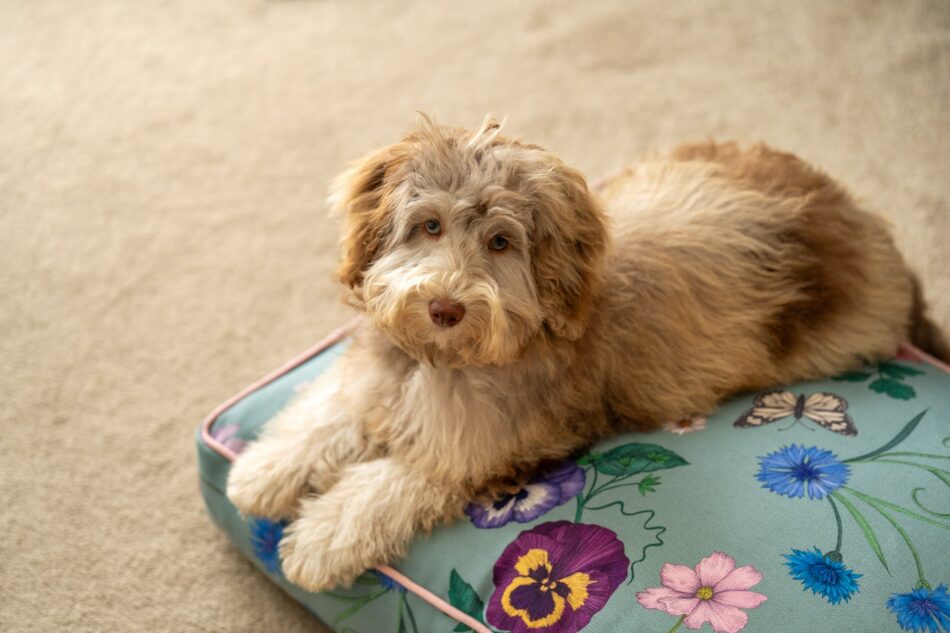
Here for the homebodies
Perhaps a slow stroll with your dog followed by a cozy evening in your beautifully decorated home sounds more appealing than a camping trip with Fido? We’ve got a dog bed just for you, too. Our Nest dog bed has been designed to give your dog the ultimate night’s sleep with dual-side cushion inserts, whilst looking amazing in any home as well.
Choose from a range of sustainably sourced covers in signature prints, exclusive to Omlet. For those who want a bold pop of color, the abstract Kaleidoscope Prism or Shaded Spruce prints will work great. And to complement any minimalist interior, the subtle tones of the Corduroy Pebble and Corduroy Moss covers are ideal.
Omlet and your dog’s bed
No two dogs are the same, so we don’t expect them to have the same needs and desires. That’s why we’ve designed a comprehensive collection of dog beds that meet their needs – and yours too. From the Bolster dog bed for extra support, to Topology dog beds for those all-important life stages, to the sustainable and beautifully designed Nest dog bed, or the Cushion dog bed to travel anywhere, we believe the perfect dog bed makes life with your dog that bit more magic for you both.
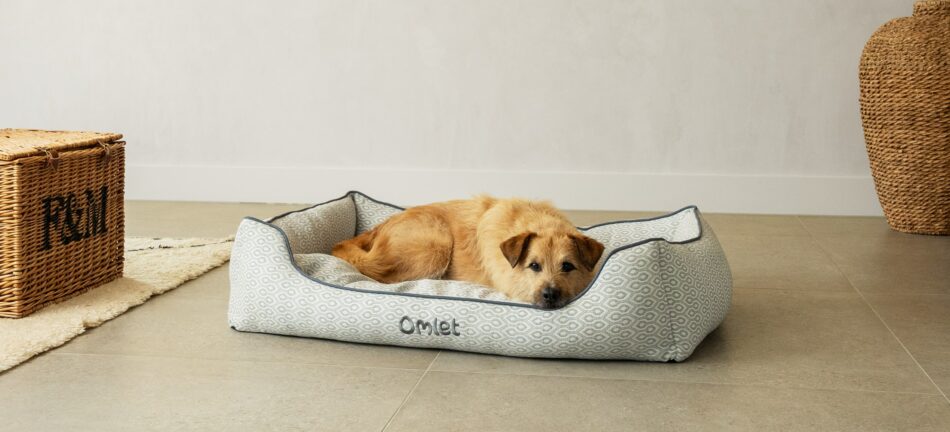

*180_Puppy-Gaurantee_terms | Omlet
This entry was posted in Dogs











































